Motorola Mobility P56JK2 Portable Cellular/ PCS GSM/ EDGE Transceiver with Bluetooth User Manual Exhibit 8 Users Manual
Motorola Mobility LLC Portable Cellular/ PCS GSM/ EDGE Transceiver with Bluetooth Exhibit 8 Users Manual
Exhibit 8 Users Manual

MOTORAZR™
VE66
User’s Guide
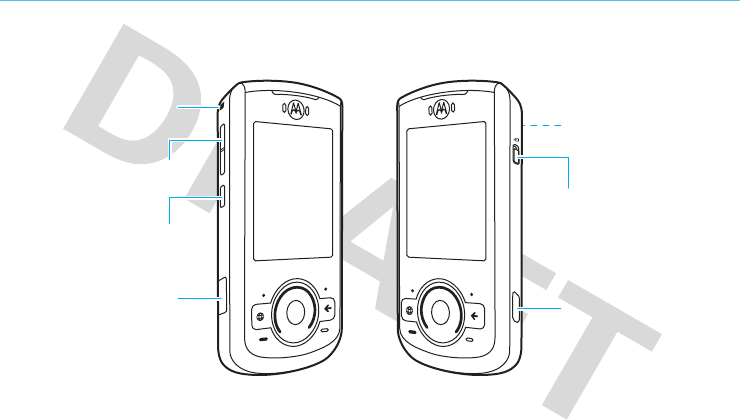
1
HELLOMOTO
Introducing your new MOTO
RAZR™
VE66 GSM wireless phone. Here’s a quick anatomy lesson.
Lanyard Hook
Side Select Key
Micro USB Port
Volume Keys
Lock Key
Camera Key
Camera Lens & Flash
(on back of phone)
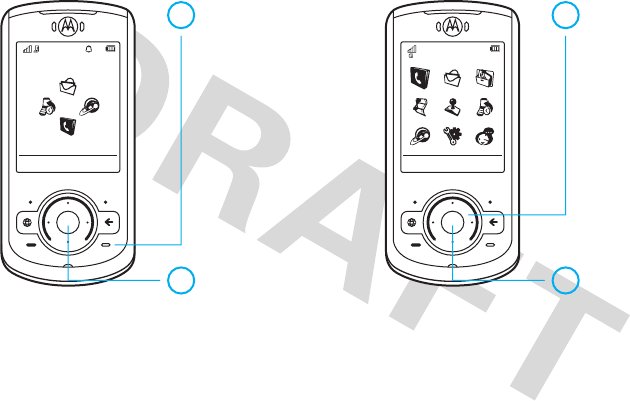
2
Note:
This is the standard home screen and main menu layout.
Your phone’s home screen and main menu may
be different.
To change your home screen shortcuts and main menu appearance, see your Quick Start Guide.
Service Provider
10/15/2009
10:10
Shortcuts Main Menu Options Back
Phonebook
Home Screen Main Menu
Press
s
to select it.
4
Press
S
up/down/left/right
to scroll to a
menu feature.
3
Press & hold
–
until the display
lights up.
1
Press
s
to open
the
Main Menu
.
2

3
Motorola, Inc.
Consumer Advocacy Office
1307 East Algonquin Road
Schaumburg, IL 60196
www.hellomoto.com
1-800-331-6456 (United States)
1-888-390-6456 (TTY/TDD United States for hearing impaired)
1-800-461-4575 (Canada)
Certain mobile phone features are dependent on the capabilities and
settings of your service provider’s network. Additionally, certain
features may not be activated by your service provider, and/or the
provider’s network settings may limit the feature’s functionality. Always
contact your service provider about feature availability and functionality.
All features, functionality, and other product specifications, as well as
the information contained in this user’s guide are based upon the latest
available information and are believed to be accurate at the time of
printing. Motorola reserves the right to change or modify any
information or specifications without notice or obligation.
MOTOROLA and the Stylized M Logo are registered in the US Patent &
Trademark Office. The Bluetooth trademarks are owned by their
proprietor and used by Motorola, Inc. under license. Java and all other
Java-based marks are trademarks or registered trademarks of Sun
Microsystems, Inc. in the U.S. and other countries. Microsoft and
Windows are registered trademarks of Microsoft Corporation; and
Windows XP and Windows Media are trademarks of Microsoft
Corporation. Macintosh is a registered trademark of Apple Computer,
Inc.
l
is a Certification Mark of the Wireless Fidelity Alliance,
Inc.
All other product or service names are the property of their
respective owners.
© 2008 Motorola, Inc. All rights reserved.
Caution:
Changes or modifications made in the radio phone, not
expressly approved by Motorola, will void the user’s authority to operate
the equipment.
Software Copyright Notice
The Motorola products described in this manual may include
copyrighted Motorola and third-party software stored in semiconductor
memories or other media. Laws in the United States and other countries
preserve for Motorola and third-party software providers certain
exclusive rights for copyrighted software, such as the exclusive rights to
distribute or reproduce the copyrighted software. Accordingly, any
copyrighted software contained in the Motorola products may not be
modified, reverse-engineered, distributed, or reproduced in any manner
to the extent allowed by law. Furthermore, the purchase of the Motorola
products shall not be deemed to grant either directly or by implication,
estoppel, or otherwise, any license under the copyrights, patents, or
patent applications of Motorola or any third-party software provider,
except for the normal, non-exclusive, royalty-free license to use that
arises by operation of law in the sale of a product.
Manual Number: 68XXXXX296-A

4
contents
contents
Safety Information . . . . . . . . . . 6
FCC Notice. . . . . . . . . . . . . . . . 10
Use and Care . . . . . . . . . . . . . . 11
EU Conformance . . . . . . . . . . . 12
Recycling Information. . . . . . . 13
get started . . . . . . . . . . . . . . . . 14
about this guide . . . . . . . . . . 14
battery . . . . . . . . . . . . . . . . . 14
basics . . . . . . . . . . . . . . . . . . . . 18
display. . . . . . . . . . . . . . . . . . 18
volume . . . . . . . . . . . . . . . . . 21
side select key . . . . . . . . . . . 21
voice commands . . . . . . . . . 21
talking phone . . . . . . . . . . . . 23
handsfree speaker . . . . . . . . 24
codes & passwords . . . . . . . 24
lock & unlock phone. . . . . . . 25
lock your SIM card
or applications . . . . . . . . . . . 25
personalize . . . . . . . . . . . . . . . 26
alert styles . . . . . . . . . . . . . . 26
time & date . . . . . . . . . . . . . 27
themes. . . . . . . . . . . . . . . . . 28
display appearance. . . . . . . . 30
more personalizing features . 31
calls . . . . . . . . . . . . . . . . . . . . . 33
voice quality . . . . . . . . . . . . . 33
turn off a call alert . . . . . . . . 33
recent calls. . . . . . . . . . . . . . 33
redial . . . . . . . . . . . . . . . . . . 34
return a call . . . . . . . . . . . . . 34
caller ID . . . . . . . . . . . . . . . . 35
emergency calls. . . . . . . . . . 35
handsfree . . . . . . . . . . . . . . 36
answer options . . . . . . . . . . 36
call times & costs . . . . . . . . 37
more calling features. . . . . . 38
text entry . . . . . . . . . . . . . . . . 42
word mode . . . . . . . . . . . . . 43
abc mode . . . . . . . . . . . . . . 44
numeric mode . . . . . . . . . . . 45
symbol mode . . . . . . . . . . . 45
entertainment . . . . . . . . . . . . 46
browser . . . . . . . . . . . . . . . . 46
fun & games . . . . . . . . . . . . 48
messages . . . . . . . . . . . . . . . . 49
voicemail . . . . . . . . . . . . . . . 49
text messages. . . . . . . . . . . 49
instant messaging . . . . . . . . 51
more message features . . . 52

5
contents
tools . . . . . . . . . . . . . . . . . . . . 55
contacts . . . . . . . . . . . . . . . 55
personal organizer. . . . . . . . 58
connections . . . . . . . . . . . . . . 62
Bluetooth® wireless . . . . . . 62
WiFi Internet connection. . . 66
cable connections . . . . . . . . 70
sync. . . . . . . . . . . . . . . . . . . 72
file manager . . . . . . . . . . . . 73
phone software updates . . . 75
service & repairs . . . . . . . . . . . 76
SAR Data . . . . . . . . . . . . . . . . 77
WHO Information . . . . . . . . . 78
Privacy and Data Security. . . 78
OSS Information . . . . . . . . . . 79
Driving Safety . . . . . . . . . . . . 79
index . . . . . . . . . . . . . . . . . . . . 81

6
Safety Information
Safety and General Information
Safety Information
This section contains important information on the safe and
efficient operation of your mobile device. Read this information
before using your mobile device.
Exposure to Radio Frequency (RF) Energy
Your mobile device contains a transmitter and receiver. When it is ON, it
receives and transmits RF energy. When you communicate with your
mobile device, the system handling your call controls the power level at
which your mobile device transmits.
Your Motorola mobile device is designed to comply with local regulatory
requirements in your country concerning exposure of human beings to
RF energy.
Operational Precautions
For optimal mobile device performance, and to be sure that human
exposure to RF energy does not exceed the guidelines set forth in the
relevant standards, always follow these instructions and precautions.
Product Operation
When placing or receiving a phone call, hold your mobile device just like
you would a landline phone.
If you wear the mobile device on your body, always place the mobile
device in a Motorola-supplied or approved clip, holder, holster, case, or
body harness. If you do not use a body-worn accessory supplied or
approved by Motorola—or if you hang your mobile device from a
lanyard around your neck—keep the mobile device and its antenna at
least 2.5 centimeters (1 inch) from your body when transmitting.
Using accessories not supplied or approved by Motorola may cause your
mobile device to exceed RF energy exposure guidelines. For a list of
Motorola-supplied or approved accessories, visit our Web site at:
www.motorola.com
.
RF Energy Interference/Compatibility
Nearly every electronic device is subject to RF energy interference from
external sources if inadequately shielded, designed, or otherwise
configured for RF energy compatibility. In some circumstances your
mobile device may cause interference with other devices.
Follow Instructions to Avoid Interference Problems
Turn off your mobile device in any location where posted notices
instruct you to do so.
In an aircraft, turn off your mobile device whenever instructed to do so
by airline staff. If your mobile device offers an airplane mode or similar
feature, consult airline staff about using it in flight.
Implantable Medical Devices
If you have an implantable medical device, such as a pacemaker or
defibrillator, consult your physician before using this mobile device.
Persons with implantable medical devices should observe the following
precautions:
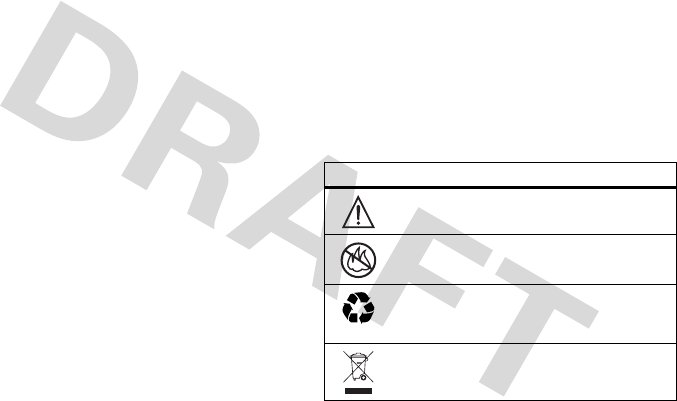
7
Safety Information
•
ALWAYS keep the mobile device more than 20 centimeters
(8 inches) from the implantable medical device when the
mobile device is turned ON.
•
DO NOT carry the mobile device in the breast pocket.
•
Use the ear opposite the implantable medical device to
minimize the potential for interference.
•
Turn OFF the mobile device immediately if you have any
reason to suspect that interference is taking place.
Read and follow the directions from the manufacturer of your
implantable medical device. If you have any questions about using your
mobile device with your implantable medical device, consult your
healthcare provider.
Driving Precautions
The use of wireless phones while driving may cause distraction.
Discontinue a call if you can’t concentrate on driving.
Additionally, the use of wireless devices and their accessories may be
prohibited or restricted in certain areas. Always obey the laws and
regulations on the use of these products.
Responsible driving practices can be found in the “Smart Practices
While Driving” section in this guide (or separate guide).
Operational Warnings
Obey all posted signs when using mobile devices in public areas.
Potentially Explosive Atmospheres
Areas with potentially explosive atmospheres are often, but not always,
posted and can include fueling areas, such as below decks on boats,
fuel or chemical transfer or storage facilities, or areas where the air
contains chemicals or particles, such as grain dust, or metal powders.
When you are in such an area, turn off your mobile device, and do not
remove, install, or charge batteries. In such areas, sparks can occur and
cause an explosion or fire.
Symbol Key
Your battery, charger, or mobile device may contain symbols, defined as
follows:
Symbol Definition
Important safety information follows.
Do not dispose of your battery or mobile device in a
fire.
Your battery or mobile device may require recycling in
accordance with local laws. Contact your local
regulatory authorities for more information.
Do not throw your battery or mobile device in the
trash.
032374o
032376o
032375o
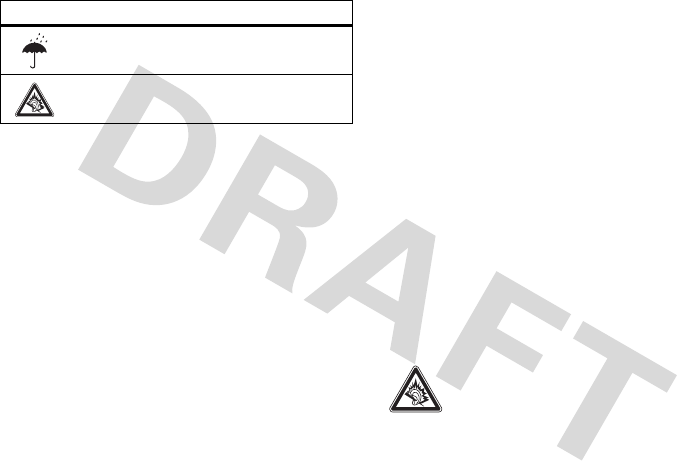
8
Safety Information
Batteries & Chargers
Caution: Improper treatment or use of batteries may present a
danger of fire, explosion, leakage, or other hazard. For more
information, see the “battery use & safety” section in the user’s
guide.
Keep Your Mobile Device and Its
Accessories Away From Small Children
These products are not toys and may be hazardous to children. For
example:
•
A choking hazard may exist for small, detachable parts.
•
Improper use could result in loud sounds, possibly causing
hearing injury.
•
Improperly handled batteries could overheat and cause a burn.
Glass Parts
Some parts of your mobile device may be made of glass. This glass
could break if the product is dropped on a hard surface or receives a
substantial impact. If glass breaks, do not touch or attempt to remove.
Stop using your mobile device until the glass is replaced by a qualified
service center.
Seizures/Blackouts
Some people may be susceptible to epileptic seizures or blackouts when
exposed to flashing lights, such as when playing video games. These
may occur even if a person has never had a previous seizure or blackout.
If you have experienced seizures or blackouts, or if you have a family
history of such occurrences, please consult with your physician before
playing video games or enabling a flashing-lights feature (if available)
on your mobile device.
Discontinue use and consult a physician if any of the following
symptoms occur: convulsion, eye or muscle twitching, loss of
awareness, involuntary movements, or disorientation. It is always a
good idea to hold the screen away from your eyes, leave the lights on in
the room, take a 15-minute break every hour, and stop use if you are
tired.
Caution About High Volume Usage
Warning:
Exposure to loud noise from any source for
extended periods of time may affect your hearing. The
louder the volume sound level, the less time is required
before your hearing could be affected. To protect your
hearing:
•
Limit the amount of time you use headsets or headphones at
high volume.
Do not let your battery, charger, or mobile device get
wet.
Listening at full volume to music or voice through a
headset may damage your hearing.
Symbol Definition

9
Safety Information
•
Avoid turning up the volume to block out noisy surroundings.
•
Turn the volume down if you can’t hear people speaking near
you.
If you experience hearing discomfort, including the sensation of
pressure or fullness in your ears, ringing in your ears, or muffled speech,
you should stop listening to the device through your headset or
headphones and have your hearing checked.
For more information about hearing, see our Web site at
www.motorola.com/hearingsafety
(in English only).
Repetitive Motion
When you repetitively perform actions such as pressing keys or entering
finger-written characters, you may experience occasional discomfort in
your hands, arms, shoulders, neck, or other parts of your body. If you
continue to have discomfort during or after such use, stop use and see a
physician.
[Mar0108]

10
FCC Notice
FCC Notice to Users
FCC Notice
The following statement applies to all products that have
received FCC approval. Applicable products bear the FCC logo,
and/or an FCC ID in the format FCC-ID:xxxxxx on the product
label.
Motorola has not approved any changes or modifications to this device
by the user. Any changes or modifications could void the user’s authority
to operate the equipment. See 47 CFR Sec. 15.21.
This device complies with part 15 of the FCC Rules. Operation is subject
to the following two conditions: (1) This device may not cause harmful
interference, and (2) this device must accept any interference received,
including interference that may cause undesired operation. See 47 CFR
Sec. 15.19(3).
This equipment has been tested and found to comply with the limits for
a Class B digital device, pursuant to part 15 of the FCC Rules. These
limits are designed to provide reasonable protection against harmful
interference in a residential installation. This equipment generates,
uses and can radiate radio frequency energy and, if not installed and
used in accordance with the instructions, may cause harmful
interference to radio communications. However, there is no guarantee
that interference will not occur in a particular installation. If this
equipment does cause harmful interference to radio or television
reception, which can be determined by turning the equipment off and
on, the user is encouraged to try to correct the interference by one or
more of the following measures:
•
Reorient or relocate the receiving antenna.
•
Increase the separation between the equipment and the
receiver.
•
Connect the equipment to an outlet on a circuit different from
that to which the receiver is connected.
•
Consult the dealer or an experienced radio/TV technician for
help.
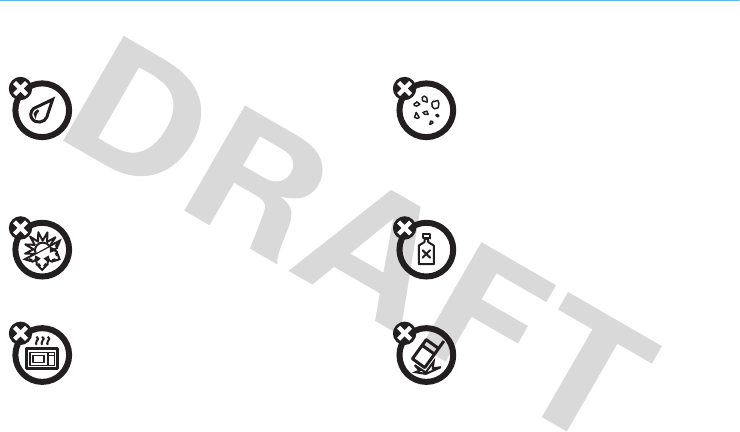
11
Use and Care
Use and Care
Use and Care
To care for your Motorola phone, please keep it away from:
liquids of any kind dust and dirt
Don’t expose your phone to water, rain, extreme
humidity, sweat, or other moisture. If it does get
wet, don’t try to accelerate drying with the use of
an oven or dryer, as this may damage the phone.
Don’t expose your phone to dust, dirt, sand, food,
or other inappropriate materials.
extreme heat or cold cleaning solutions
Avoid temperatures below 0°C/32°F or
above 45°C/113°F.
To clean your phone, use only a dry soft cloth. Don’t
use alcohol or other cleaning solutions.
microwaves the ground
Don’t try to dry your phone in a microwave oven. Don’t drop your phone.
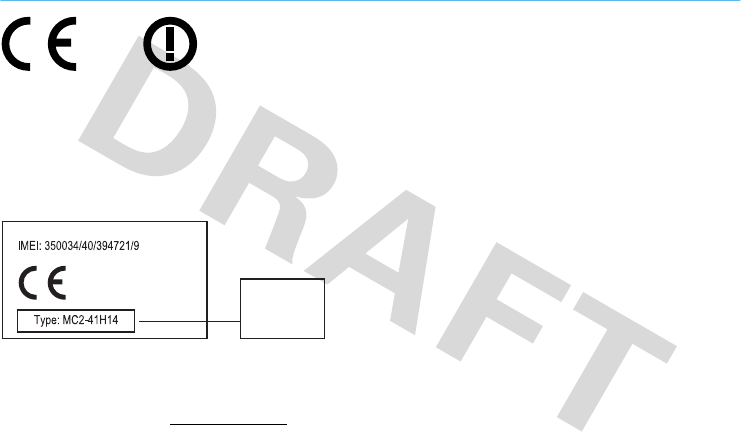
12
EU Conformance
European Union Directives Conformance Statement
EU Conformanc e
Hereby, Motorola declares that this product is in compliance with:
•
The essential requirements and other relevant provisions of
Directive 1999/5/EC
•
All other relevant EU Directives
The above gives an example of a typical Product Approval Number.
You can view your product’s Declaration of Conformity (DoC) to Directive
1999/5/EC (to R&TTE Directive) at
www.motorola.com/rtte
. To find your
DoC, enter the Product Approval Number from your product’s label in the
“Search” bar on the Web site.
[France Only]
0168
Product
Approval
Number

13
Recycling Information
Caring for the Environment by Recycling
Recycli ng Inform ation
This symbol on a Motorola product means the product should
not be disposed of with household waste.
Disposal of your Mobile Device and
Accessories
Please do not dispose of mobile devices or electrical accessories (such
as chargers, headsets, or batteries) with your household waste. These
items should be disposed of in accordance with the national collection
and recycling schemes operated by your local or regional authority.
Alternatively, you may return unwanted mobile devices and electrical
accessories to any Motorola Approved Service Center in your region.
Details of Motorola approved national recycling schemes, and further
information on Motorola recycling activities can be found at:
www.motorola.com/recycling
Disposal of your Mobile Device Packaging
and User’s Guide
Product packaging and user’s guides should only be disposed of in
accordance with national collection and recycling requirements. Please
contact your regional authorities for more details.
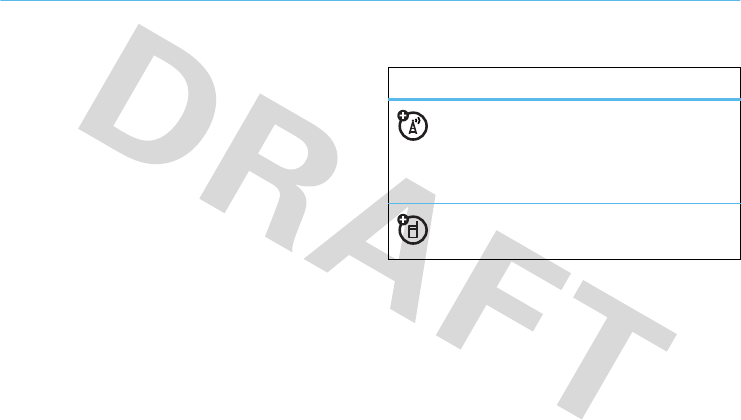
14
get started
get started
about this guide
This guide shows how to locate a menu feature as
follows:
Find it:
s
>
jMultimedia
>
Camera
This means that, from the home screen:
1
Press the center key
s
to open the menu.
2
Press the navigation key
S
to scroll to
jMultimedia
, and press
s
to select it.
3
Press
S
to scroll to
Camera
, and press
s
to
select it.
This guide uses the following symbols:
battery
battery charging notes
For instructions on charging the battery, see your
Quick Start Guide.
symbols
This means a feature is network, SIM card,
or subscription dependent and may not be
available in all areas. Contact your service
provider for more information.
This means a feature requires an optional
accessory.
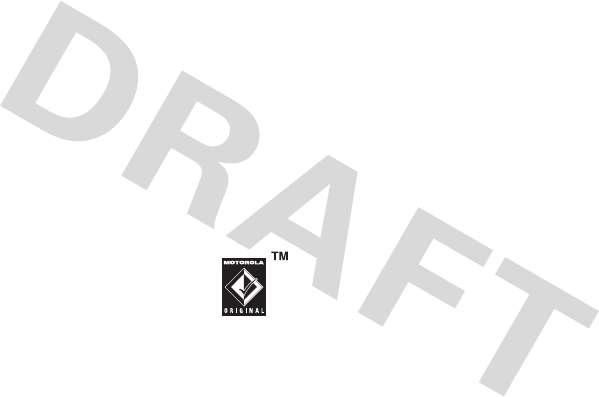
15
get started
Notes for charging your phone’s battery:
•
When charging your battery, keep it near room
temperature. Never expose batteries to
temperatures below 0°C (32°F) or above 45°C
(113°F) when charging.
•
New batteries are not fully charged.
•
New batteries or batteries stored for a long
time may take more time to charge.
•
Motorola batteries and charging systems have
circuitry that protects the battery from damage
from overcharging.
Note:
You can charge your battery by
connecting a cable from your phone’s
micro USB port to a USB port on a
computer. Both your phone and the
computer must be turned on, and your computer must
have the correct software drivers installed. A
Motorola Original USB cable and supporting software
may be included with your phone. These tools are also
sold separately.
battery use & safety
IMPORTANT: HANDLE AND STORE BATTERIES
PROPERLY TO AVOID INJURY OR DAMAGE.
Most
battery issues arise from improper handling of
batteries, and particularly from the continued use of
damaged batteries.
DON’Ts
• Don’t disassemble, crush, puncture, shred,
or otherwise attempt to change the form of
your battery.
• Don’t let the phone or battery come in
contact with water.
Water can get into the
phone’s circuits, leading to corrosion. If the
phone and/or battery get wet, have them
checked by your carrier or contact Motorola,
even if they appear to be working properly.

16
get started
• Don’t allow the battery to touch metal
objects.
If metal objects, such as jewelry, stay
in prolonged contact with the battery contact
points, the battery could become very hot.
• Don’t place your battery near a heat source.
Excessive heat can damage the phone or the
battery. High temperatures can cause the
battery to swell, leak, or malfunction.
Therefore:
•
Do
not
dry a wet or damp battery with an
appliance or heat source, such as a hair
dryer or microwave oven.
•
Avoid leaving your phone in your car in high
temperatures.
DOs
• Do avoid dropping the battery or phone.
Dropping these items, especially on a hard
surface, can potentially cause damage.
• Do contact your service provider or
Motorola if your phone or battery has been
damaged from dropping or high
temperatures.
IMPORTANT: USE MOTOROLA ORIGINAL
PRODUCTS FOR QUALITY ASSURANCE AND
SAFEGUARDS.
To aid consumers in identifying
authentic Motorola batteries from non-original or
counterfeit batteries (that may not have adequate
safety protection), Motorola provides holograms on its
batteries. Consumers should confirm that any battery
they purchase has a “Motorola Original” hologram.
Motorola recommends you always use
Motorola-branded batteries and chargers.
Motorola
mobile devices are designed to work with Motorola
batteries. If you see a message on your display such as
Invalid Battery
or
UnabletoCharge
, take the following steps:
•
Remove the battery and inspect it to confirm
that it has a “Motorola Original” hologram;

17
get started
•
If there is no hologram, the battery is not a
Motorola battery;
•
If there is a hologram, replace the battery and
retry charging it;
•
If the message remains, contact a Motorola
Authorized Service Center.
Important:
Motorola’s warranty does not cover
damage to the phone caused by non-Motorola batteries
and/or chargers.
Warning:
Use of a non-Motorola battery or charger may
present a risk of fire, explosion, leakage, or other
hazard.
PROPER AND SAFE BATTERY DISPOSAL AND
RECYCLING
Proper battery disposal is not only important for safety,
it benefits the environment. Consumers may recycle
their used batteries in many retail or service provider
locations. Additional information on proper disposal and
recycling may be found on the Web:
•
www.motorola.com/recycling
•
www.rbrc.org/call2recycle/
(in English only)
Disposal:
Promptly dispose of used batteries
in accordance with local regulations. Contact
your local recycling center or national recycling
organizations for more information on how to dispose
of batteries.
Warning:
Never dispose of batteries in a fire because
they may explode.
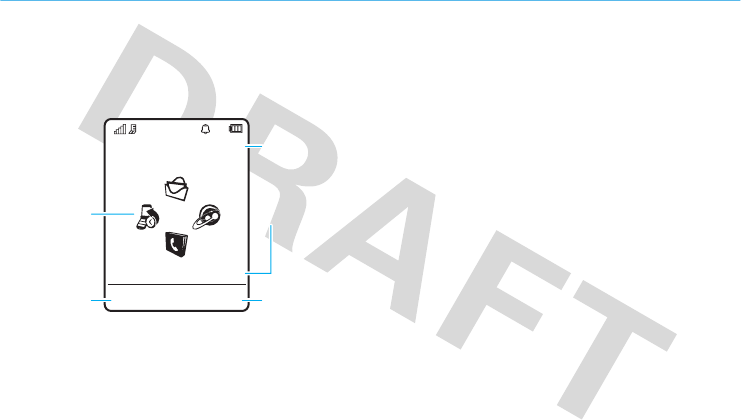
18
basics
basics
display
The home screen appears when you turn on the phone.
Note:
Your home screen may look different, depending
on your service provider.
To dial a number from the home screen, press number
keys and
¯
.
Press the center key
s
or the
Main Menu
soft key to
open the main menu.
Press
Shortcuts
in the home screen to access some
frequently-used phone features.
Press the navigation key
S
up, down, left, or right in
the home screen to open basic features. To show, hide,
or change feature icons in the home screen, see your
Quick Start Guide.
Tip:
Want some help? Press
s
>
mTools
>
Help
.
Select a
Help
topic to find information about phone
features.
Date
Clock
Service Provider
10/15/2009
10:10
Shortcuts Main Menu
Feature Icons
Left Soft Key
Label
Right Soft Key
Label
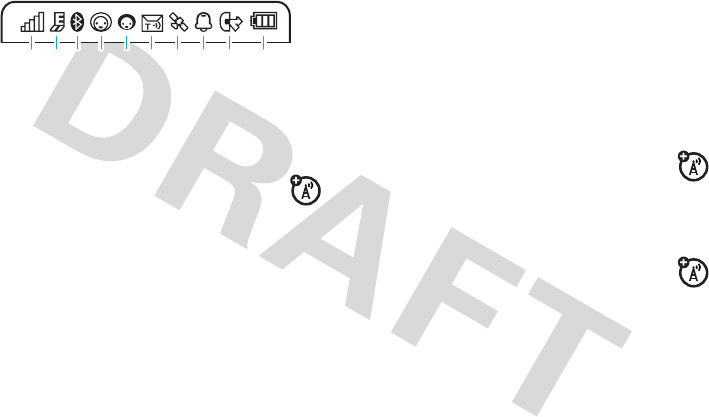
19
basics
Status indicators appear at the top of the home screen:
1Signal Strength Indicator –
Shows the strength
of the wireless network connection.
2EDGE/GPRS Indicator –
Shows when your
phone is using a high-speed Enhanced Data
for GSM Evolution (EDGE) network connection
Z
,
or General Packet Radio Service (GPRS) network
connection
g
.
3Bluetooth/WiFi Indicator –
When Bluetooth
power is turned on, the Bluetooth indicator shows
Bluetooth status:
The WiFi indicator
l
appears in red when
WiFi power is turned on. The WiFi indicator
turns green when your phone establishes a WiFi
network connection through an access point.
4Messaging Presence Indicator –
Shows
your instant messaging (IM) status:
210613 9
8
45 7
&
(solid blue) = Bluetooth powered on
&
(solid green) = Bluetooth connected
&
(flashing blue) = Bluetooth discoverable mode
0
(green) = online
2
= offline
Y
= busy
4
= discrete
3
(gray) = invisible to
IM

20
basics
5IM Indicator –
Shows when you receive a
new IM message.
6Message Indicator –
Shows when you
receive a new text or voice message. Other
indicators can include:
7Location Indicator –
Shows
P
when your
phone is providing location information to
the network, or
Q
when location information is
turned off.
8Alert Style Indicator –
Shows the alert style
setting:
9Active Line Indicator –
Shows
B
to
indicate an active call, or
E
to indicate
when call forwarding is on. Indicators for
dual-line-enabled SIM cards can include:
10 Battery Level Indicator –
Vertical bars show the
battery charge level. Recharge the battery when
your phone shows
Low Battery
.
]
= text message
(
= voicemail
message
V
= email message
N
= ring loud
N
= ring soft
K
= ring and vibrate
I
= vibrate then ring
H
= vibrate only
J
= silent
G
= line 1 active
F
= line 2 active
D
= line 1
call forward on
C
= line 2
call forward on
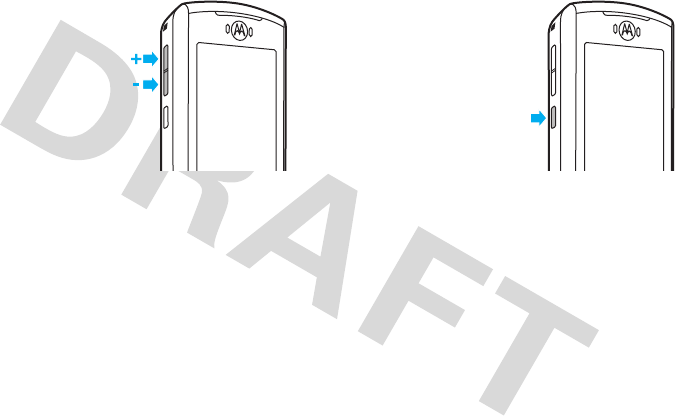
21
basics
volume
Press the volume keys to:
•
turn off an incoming
call alert
•
change earpiece or
speakerphone
volume during a call
•
change playback
volume for a song or video
•
change radio volume
•
set your phone’s alert style in the home screen
(press the volume keys to scroll to an alert
style, then press
s
or the side select key to
select it)
side select key
The side select key gives you
another way to do things. For
example, when you scroll to a
menu item, you can press the
side select key to select it
(instead of pressing
s
).
voice
commands
You can use voice commands to tell your phone what
to do.
Note:
Not all languages support voice commands.

22
basics
voice dial a call
You can dial a contact list entry by speaking its name, or
dial any phone number by speaking its digits.
1
Press and hold
¯
. The phone loads the voice
recognition software, then prompts you to say a
command or name.
2
Wait for the beep, then say the
full name
of the
contact as it appears in your contact list (for
example, “John Smith”). Your phone confirms the
name and makes the call.
or
Say “Dial Number.” Your phone prompts you to
speak the digits in the phone number. Speak the
digits. Your phone confirms the number and makes
the call.
Tips:
•
You can say a contact’s name and number type
together. For example, say “John Smith
mobile” to call the mobile number stored for
John Smith.
•
For voice command help, press and hold
¯
,
then press
Help
.
voice activate phone functions
You can use voice commands to open applications and
perform many basic phone functions.
1
Press and hold
¯
. The phone prompts you to say
a command.
2
Wait for the beep, then say a command from the
list.
voice commands
“
<Name>
”
“
Dial Number
”
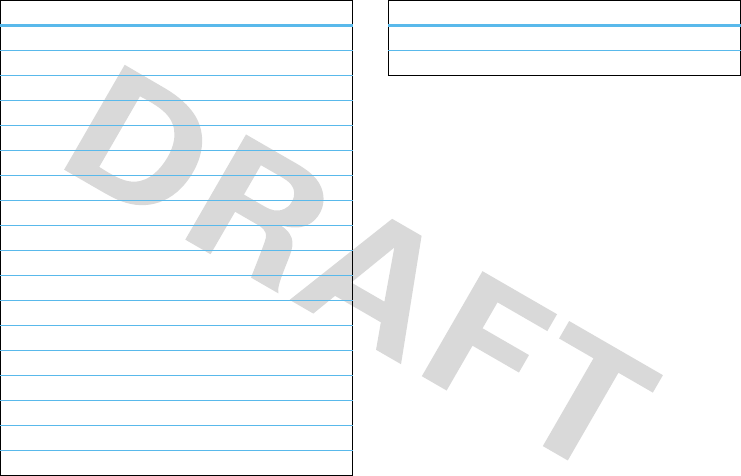
23
basics
Tip:
Press and hold
¯
to see the list of voice
commands.
talking phone
You can set your phone to read the names of menu
features or contact list entries, recite phone number
digits you type in the home screen, and/or read text
messages or email messages you receive (in English
only).
Find it:
s
>
uSettings
>
Phone Settings
>
Talking Phone
Shortcut:
Press and hold
¯
. When the phone
prompts you to say a command, say “Talking Phone.”
“
Send Message To <Name>
”
“
Check Calendar
”
“
Check New Message
”
“
Check New Email
”
“
Add New Contact
”
“
Talking Phone
”
“
Check Battery
”
“
Check Signal
”
“
Check Time
”
“
Check Date
”
“
Open Setup
”
“
Open Recent Calls
”
“
Open Theme
”
“
Open Camera
”
“
Open Web Access
”
“
Set Ring Loud
”
“
Set Vibrate
”
“
Set Silent
”
voice commands
“
Set Airplane
”
“
Set Airplane Off
”
voice commands

24
basics
handsfree speaker
During a call, press
Options
>
Speaker On
to turn the
handsfree speaker on. Your display shows the
speakerphone indicator until you turn it off (press
Options
>
Speaker Off
) or end the call.
Note:
The use of wireless phones while driving may
cause distraction. Discontinue a call if you can’t
concentrate on driving. Additionally, the use of wireless
devices and their accessories may be prohibited or
restricted in certain areas. Always obey the laws and
regulations on the use of these products.
codes & passwords
Your phone’s four-digit
unlock code
is originally set to
1234
. The six-digit
security code
is originally set to
000000
. If your service provider didn’t change these
codes, you should change them:
Find it:
s
>
uSettings
>
Security
>
Change Passwords
You can also change your
SIM PIN
codes or call barring
password.
If you forget your unlock code:
At the
Please verify the Unlock Code
prompt, try entering 1234 or the
last four digits of your phone number. If that doesn’t
work, press
#
to enter your six-digit security code
instead.
If you forget other codes:
If you forget your security
code, SIM PIN code, PIN2 code, or call barring
password, contact your service provider.

25
basics
lock & unlock phone
You can lock your phone to keep others from using it.
You must enter the four-digit unlock code to lock or
unlock your phone.
To
manually lock
your phone:
Find it:
s
>
uSettings
>
Security
>
Phone Lock
>
Lock Now
To
automatically lock
your phone whenever you turn it
off:
Find it:
s
>
uSettings
>
Security
>
Phone Lock
>
Lock at Power On
>
On
lock your SIM card or
applications
Note:
You must enter your SIM PIN code to lock or
unlock the SIM card. If you forget your PIN code,
contact your service provider.
Caution:
If you enter an incorrect PIN code three times
before the correct code, your SIM card is disabled, and
your display shows
SIM Blocked
.
To
lock or unlock your SIM card
:
Find it:
s
>
uSettings
>
Security
>
SIM PIN Lock
To
lock an application
(such as
Messages
):
Find it:
s
>
uSettings
>
Security
>
Application Lock
You must enter the four-digit unlock code to see the
applications list. Select an application and choose
Lock
to
lock it.

26
personalize
personalize
alert styles
You can quickly change your phone’s alert style to
match your activity or environment. Each alert style
uses a different ringtone volume and/or vibrations to
notify you of incoming calls and other events. The alert
style indicator shows at the top of the home screen.
To change your alert style:
From the home screen,
press the volume keys on the side of your phone.
Alternatively, from the home screen press
Shortcuts
>
Change Alert Style
.
The
Vibrate Only
and
Silent
alert styles silence your phone
until you set another alert style.
Shortcut:
From the home screen, press and hold
#
to quickly set the alert style to
Vibrate Only
.
change alert style settings
You can change the ringtones that notify you of
incoming calls and other events. You can also change
the keypad tone volume and slide tone. The changes
you make are applied globally to all alert styles.
Find it:
s
>
uSettings
>
Sounds & Ringtones
1
Press
S
up/down to scroll to the setting you
want to change, then press
s
.
2
Change the setting as desired.
3
Press
Back
to exit and save your changes.
NRing Loud NRing Soft
KRing and Vibrate IVibrate then Ring
HVibrate Only JSilent

27
personalize
create a new alert style
To create a
new
alert style with the ringtone volume
and event notification characteristics you specify:
Find it:
s
>
uSettings
>
Sounds & Ringtones
>
Ring Mode
>
Create Ring Mode
1
Press
S
up/down to scroll to the default alert
style name, then press
s
to select it.
2
Change the alert style name as desired.
3
Press
S
up/down to scroll to the setting you
want to change, then press
s
to select it.
4
Change the setting as desired.
5
Press
Save
to exit and save your changes.
edit or delete alert styles
To
edit
an alert style:
Find it:
s
>
uSettings
>
Sounds & Ringtones
>
Ring Mode
,
scroll to the alert style, press
Options
>
Edit Ring Mode
Note:
You can’t edit the
Vibrate Only
or
Silent
alert styles.
To
delete
a user-defined alert style:
Find it:
s
>
uSettings
>
Sounds & Ringtones
>
Ring Mode
,
scroll to the alert style, press
Options
>
Delete Ring Mode
time & date
Your phone can automatically update the time and date.
It uses the time and date for the
Calendar
.
To
synchronize
time and date with the network:
Find it:
s
>
uSettings
>
Phone Settings
>
Time & Date
>
Auto-Update Time
>
On
To
manually
set the time and date:
Find it:
s
>
uSettings
>
Phone Settings
>
Time & Date
>
Auto-Update Time
>
Off
, then scroll to and select
Time
and
Date

28
personalize
To adjust time and date, press
S
left/right to scroll to
a setting, then press
S
up/down to change it. Press
Set
to save your settings.
To show a
12-hour or 24-hour
digital clock in the home
screen:
Find it:
s
>
uSettings
>
Phone Settings
>
Time & Date
>
Time Format
>
12Hour Clock
or
24 Hour Clock
To s e t t h e
date format
in the home screen:
Find it:
s
>
uSettings
>
Phone Settings
>
Time & Date
>
Date Format
To set your
time zone
:
Find it:
s
>
uSettings
>
Phone Settings
>
Time & Date
>
Time Zone
, then select a city in your time zone
Shortcut:
Press keypad keys to enter the first letters of
the city you want.
themes
Use a phone theme to personalize the look and
sound of your phone. Most themes include a
wallpaper image, screensaver image, and ringtones.
To
apply
a theme:
Find it:
s
>
uSettings
>
Themes
> theme
To
download
a theme using your phone’s browser, see
page 46.
To
delete
a theme:
Find it:
s
>
uSettings
>
Themes
, scroll to the theme,
then press
Options
>
Manage
>
Delete
Note:
You can delete only downloaded themes or
custom themes you create.

29
personalize
preview ringtones
To preview the ringtones on your phone, and choose
the ringtone a theme uses to notify you of incoming
calls:
Find it:
s
>
uSettings
>
Themes
, press
Options
>
Edit
>
Ringtone
>
Ringtones
>
Sounds and Ringtones
>
Preloaded Ringtones
1
Press
S
up/down to scroll and listen to each
ringtone in turn.
2
Press
s
to select the highlighted ringtone.
3
Press
Save
to save your selection.
apply a photo as wallpaper
To use a photo as a background wallpaper image in your
home screen:
Find it:
s
>
uSettings
>
Themes
, press
Options
>
Edit
1
Press
S
right to select the
images
tab
$
.
2
Press
S
down to scroll to
Wallpaper
, then press
s
to select it.
3
Scroll to the photo you want to use, then press
Select
.
Note:
If the photo is stored on an installed
memory card, select
Back to Pictures
>
Back to My Files
>
Memory Card
>
MyPhotos
to search for photos on the
memory card.
4
Press
Save
to save your selection.
Photos that you copy to your phone from another
device may not scale correctly when applied as
wallpaper images. To
resize a wallpaper photo
so it
displays at the correct size:
Find it:
s
>
uSettings
>
Themes
, press
Options
>
Edit
1
Press
S
right to select the
images
tab
$
.
2
Press
S
down to scroll to
Wallpaper Layout
, then
press
s
to select it.

30
personalize
3
Scroll to
Fit-to-Screen
, then press
Select
.
4
Press
Save
to save the setting.
modify a theme
Find it:
s
>
uSettings
>
Themes
, scroll to the theme,
press
Options
>
Edit
1
Press
S
left/right to select the
sounds
tab
[
or
images
tab
$
.
2
Press
S
up/down to scroll to the setting you
want to change, then press
s
.
3
Scroll to the image or sound file you want, then
select it.
4
Press
Save
to save your theme changes.
The
Wallpaper
appears as a background image in your
home screen.
The
Screensaver
appears in the display after a period of
inactivity.
Skins
set the look and feel of your phone’s display.
To
reset
the standard settings for a modified theme:
Find it:
s
>
uSettings
>
Themes
> theme, press
Options
>
Manage
>
Reset
To
restore
the default theme on your phone:
Find it:
s
>
uSettings
>
Themes
, press
Options
>
Manage
>
Restore to Default
create a new theme
Find it:
s
>
uSettings
>
Themes
, press
Options
>
Create Theme
or
Create aCopy
display appearance
To set your display
brightness
:
Find it:
s
>
uSettings
>
Display
>
Brightness
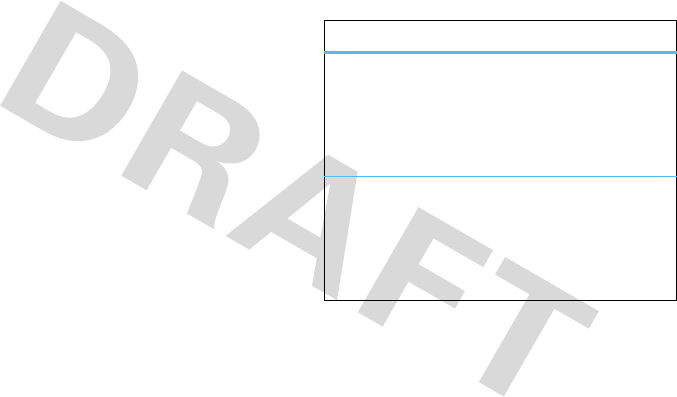
31
personalize
To save battery life, the
display
turns off when you’re
not using your phone. To set the display timeout delay
interval:
Find it:
s
>
uSettings
>
Display
>
Backlight Timeout
The display
screensaver
appears briefly when the
display timeout delay interval is reached. To turn the
screensaver off:
Find it:
s
>
uSettings
>
Display
>
Screensaver
>
None
Tip:
To extend battery life, turn off the screensaver.
more personalizing
features
features
language
Set menu language:
s
>
uSettings
>
Phone Settings
>
Language and Input
>
Language
reset settings
Reset default settings for all options
except
the
unlock code, security code, and lifetime timer:
s
>
uSettings
>
Phone Settings
>
Reset
>
Reset All Settings
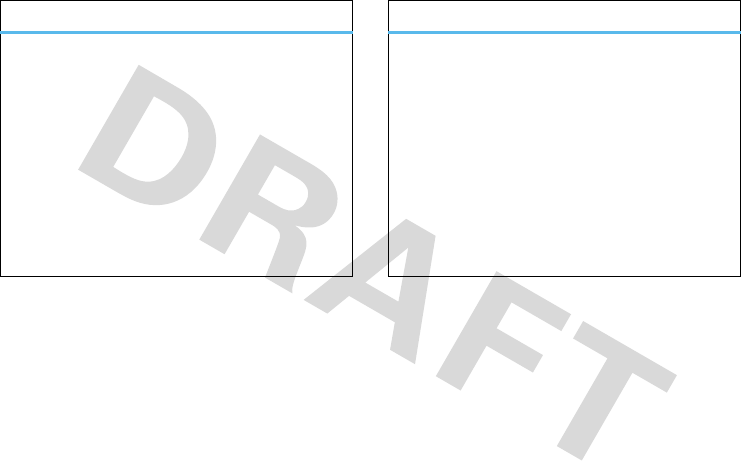
32
personalize
delete data
Caution:
This option
erases all information you
have entered
(including contacts and calendar
entries)
and content you have downloaded
(including photos and sounds) stored in your phone’s
memory. After you erase the information, you can’t
recover it. This option does
not
delete SIM card or
memory card information.
s
>
u
Settings
>
Phone Settings
>
Reset
>
Delete All Data
features
delete memory card information
Caution:
This option
erases all information you
have entered
(including contacts and calendar
entries)
and content you have downloaded
(including photos and sounds) stored on your
memory card and/or SIM card. After you erase the
information, you can’t recover it.
s
>
u
Settings
>
Phone Settings
>
Reset
>
Delete Memory Cards
features

33
calls
calls
voice quality
You can adjust audio settings for your phone’s headset
speaker, to optimize voice quality and clarity during a
call.
Find it:
s
>
uSettings
>
Call Settings
>
In-Call Setup
>
Voice Quality
Shortcut:
During a call, press
Options
>
Voice Quality
.
turn off a call alert
Press the volume keys on the side of your phone to
turn off the ringer before answering a call.
recent calls
Your phone keeps lists of incoming and outgoing calls,
even for calls that didn’t connect. The most recent calls
are listed first. The oldest calls are deleted as new calls
are added.
Find it:
s
>
qRecent Calls
Shortcut:
Press
¯
from the home screen to go to
the
All Calls
list.
1
Press
S
left/right to select a call list:
All Calls
,
Dialed Calls
,
Answered Calls
,
Missed Calls
, or
Frequent Calls
.
2
Press
S
up/down to scroll to a phone number.

34
calls
Icons indicate if the call was incoming
-
, outgoing
+
,
or missed
=
. A check mark next to the icon indicates a
connected call.
•
To call the number, press
¯
.
•
To check if a missed call left you a voicemail
message, see page 49.
•
To see call details (like time and date), press
s
.
•
Press
Options
to perform other operations on the
number (send a message, save to contacts), or
to set recent call options.
redial
1
Press
¯
in the home screen to go to the
Dialed Calls
list.
2
Scroll to the number you want to call, then press
¯
.
If you hear a
busy signal
and see
Call Failed
, press
¯
or
Retry
to redial the number. When the call
goes through, your phone shows
Connected
and connects
the call.
return a call
Your phone keeps a record of your unanswered calls,
and shows a list of the calls you’ve missed.
When you see the missed calls list, press
S
to scroll
to a call, then press
s
to see call information. To
return the call, press
¯
.

35
calls
caller ID
Calling line identification (caller ID) shows the
phone number for an incoming call.
Your phone shows the caller’s name and picture when
they’re stored in your contact list, or
Incoming Call
when
caller ID information isn’t available.
Note:
Picture IDs aren’t available for contacts stored on
the SIM card.
Tip:
Want to know who’s calling without even looking
at your phone? To give one of your contacts a special
ringtone, see page 56.
To show or hide your phone number for the next
outgoing call, enter the number you want to call, then
press
Options
>
Show ID
or
Hide ID
.
To show or hide
your phone number
for all calls:
Find it:
s
>
uSettings
>
Call Settings
>
Dialing Setup
>
My Caller ID
>
All Calls
>
Show ID
or
Hide ID
emergency calls
Your service provider programs one or more
emergency phone numbers, such as 911 or 112, on
your phone. Provided that the phone is switched on and
in network coverage, you can make emergency calls
using the programmed numbers, even when your
phone is locked or the SIM card is not inserted (where
allowed by the network operator).
Note:
Check with your service provider, as emergency
numbers vary by country. Your phone’s
pre-programmed emergency number(s) may not work
in all locations, and sometimes an emergency call
cannot be placed due to network, environmental, or
interference issues. Do not solely rely on your wireless
phone for essential communications, such as medical
emergencies.
To make an emergency call:
Turn your phone on, exit
any open application such as games, dial the
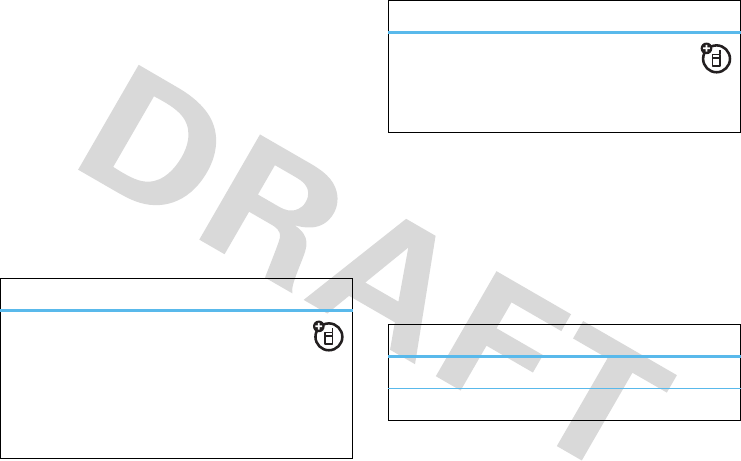
36
calls
emergency number, then press
¯
to call the
emergency number.
handsfree
Note:
The use of wireless phones while driving may
cause distraction. Discontinue a call if you can’t
concentrate on driving. Additionally, the use of wireless
devices and their accessories may be prohibited or
restricted in certain areas. Always obey the laws and
regulations on the use of these products.
answer options
You can use different ways to answer an incoming call.
To turn on or turn off an answer option:
Find it:
s
>
uSettings
>
Call Settings
>
In-Call Setup
>
Answer Options
Note:
You can always press
¯
to answer a call.
features
auto answer
(headset)
Automatically answer calls when connected
to a car kit or headset:
s
>
uSettings
>
Connections
>
Handsfree Settings
>
Auto-Answer
voice dial
(headset)
Enable voice dial with headset send/end key:
s
>
uSettings
>
Connections
>
Handsfree Settings
>
Voice Dial
option
Any Key Answer
Answer by pressing any key.
Open To Answer
Answer by opening the slider.
features
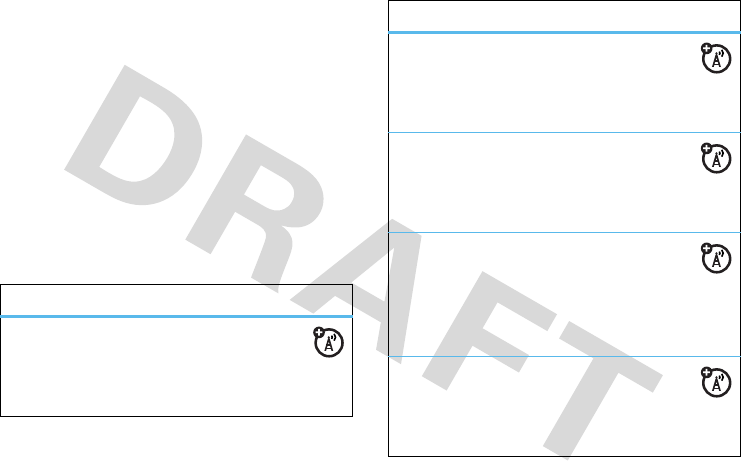
37
calls
call times & costs
Network connection time
is the elapsed time from
the moment you connect to your service provider's
network to the moment you end the call by pressing
–
. This time includes busy signals and ringing.
The amount of network connection time you track
on your resettable timer may not equal the amount
of time for which you are billed by your service
provider. For billing information, contact your
service provider.
features
call times
See call timers:
s
>
qRecent Calls
, press
Options
>
Call Times
in-call timer
Show call time information during a call:
s
>
uSettings
>
Call Settings
>
In-Call Setup
>
In-Call Timer
call costs
See call cost trackers and credit information:
s
>
qRecent Calls
, press
Options
>
Call Costs
call cost setup
Set a credit limit:
s
>
qRecent Calls
, press
Options
>
Call Costs
>
Call Cost Setup
data times
See data call timers:
s
>
qRecent Calls
, press
Options
>
DataTimes
features
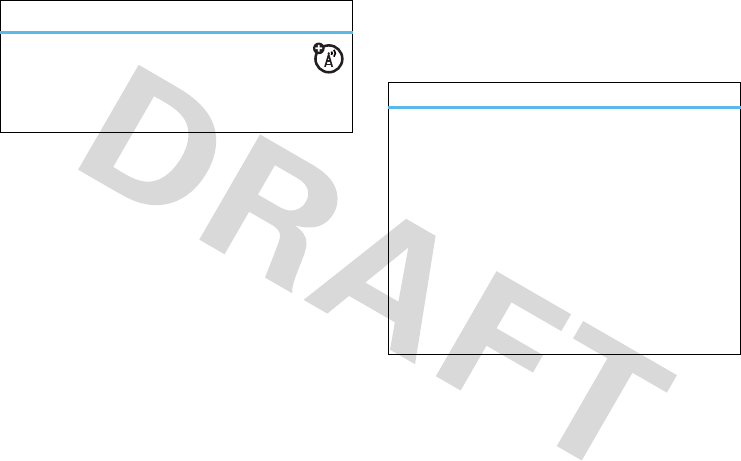
38
calls
more calling features
To use voice commands for calling, see page 21.
data volumes
See data volume meters:
s
>
qRecent Calls
, press
Options
>
DataVolumes
features
features
speed dial
Your phone can store nine phone numbers that you
can call with a single keypress. To
store
a speed dial
phone number:
s
>
LPhonebook
, press
Options
>
Settings
>
Speed DialList
>speed dial location
To
call
a speed dial number from the home screen,
press and hold the single-digit speed dial number for
one second.
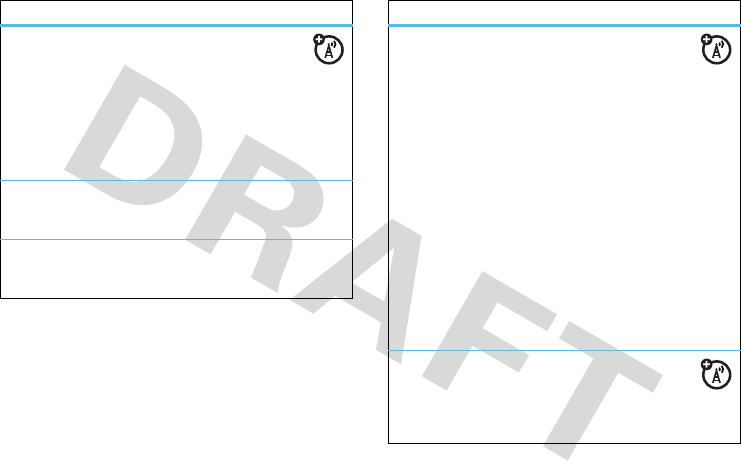
39
calls
international calls
If your phone service includes international
dialing, press and hold
0
to insert your local
international access code (indicated by
+
). Then,
press number keys to dial the country code and
phone number.
hold a call
Press
Options
>
Hold
to put all active calls on hold.
mute a call
Press
Options
>
Mute
to put all active calls on mute.
features
call waiting
When you’re on a call, you’ll hear an alert if
you receive a second call. Press
¯
to answer the
new call.
•
To switch between calls, press
Switch
.
•
To connect the two calls, press
Link
.
•
To end the call on hold, press
Options
>
End Call On Hold
.
To turn call waiting on or off:
s
>
uSettings
>
Call Settings
>
In-Call Setup
>
Call Waiting
>
On
or
Off
conference call
During a call:
Dial next number, press
¯
, press
Options
>
Link Calls
features
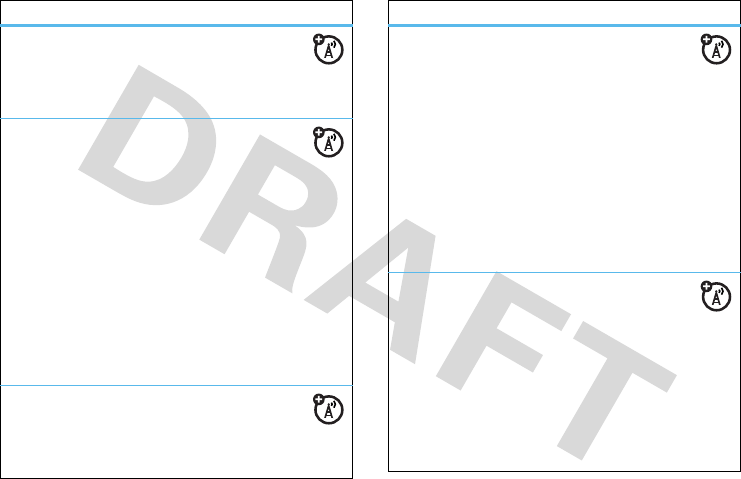
40
calls
transfer a call
During a call:
Dial next number, press
¯
, press
Options
>
Transfer Call
call forwarding
Set up call forwarding:
s
>
uSettings
>
Call Settings
>
Call Forward
>
Voice Calls
>
Forward Calls
>
All Calls
or
If Unavailable
, select
To
, then
specify the forwarding number
Cancel call forwarding:
s
>
uSettings
>
Call Settings
>
Call Forward
>
Cancel All
Note:
The
Cancel All
option cancels all call forwarding,
including data and fax calls.
blocked callers
Block various types of incoming calls:
s
>
uSettings
>
Call Settings
>
In-Call Setup
>
Blocked Callers
features
TTY calls
Note:
A teletypewriter (TTY) is a
communication device used by people who are hard
of hearing or have a speech impairment. TTY does
not work from mobile phone to mobile phone.
Set up your phone for use with an optional TTY
device:
s
>
uSettings
>
Call Settings
>
In-Call Setup
>
TTY Settings
>
TTY
change phone line
If you have a dual-line-enabled SIM card, you
can change your line to make and receive calls from
your other phone number:
s
>
uSettings
>
Call Settings
>
Active Line
The active line indicator shows the active phone line
(see illustration on page 20).
features
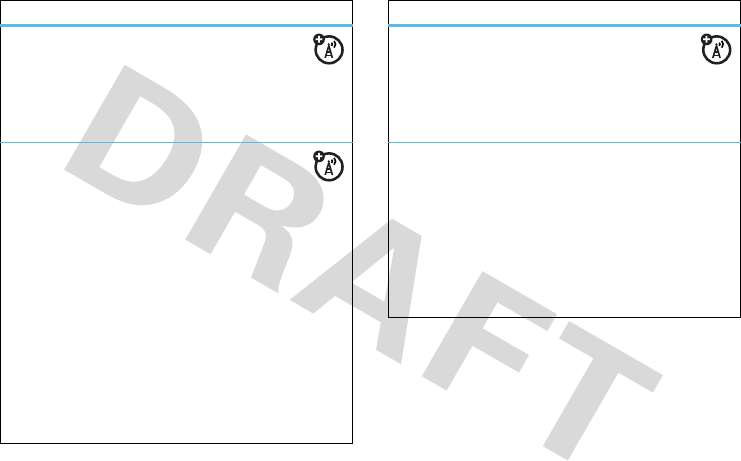
41
calls
network settings
See network information and adjust network
settings:
s
>
uSettings
>
Network Settings
fixed dial
When you turn on fixed dialing, you can call
only numbers stored in the fixed dial list.
Note:
You must enter your SIM PIN2 code to turn
fixed dialing on or off. If you forget your PIN2 code,
contact your service provider.
Turn fixed dialing on or off:
s
>
uSettings
>
Call Settings
>
Fixed Dialing
>
On
or
Off
Use the fixed dial list:
s
>
mTools
>
Dialing Services
>
Fixed Dial
features
service dial
Dial service phone numbers stored by your
service provider:
s
>
mTools
>
Dialing Services
>
Service Dial
DTMF tones
Activate DTMF tones:
s
>
uSettings
>
Call Settings
>
Dialing Setup
>
DTMF
>
Long
or
Short
To send DTMF tones during a call, just press the
number keys.
features
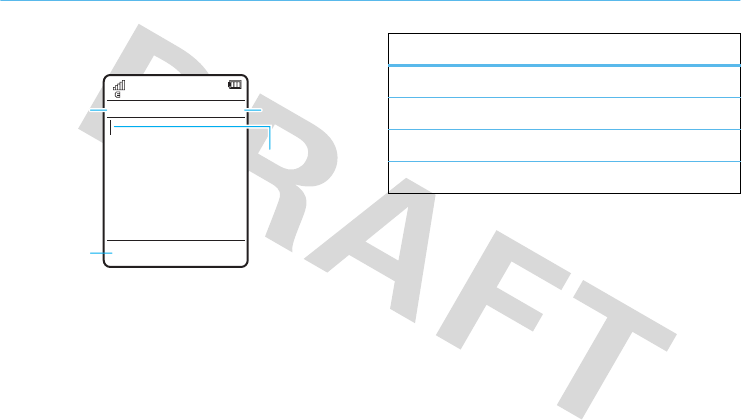
42
text entry
text entry
Some features let you enter text.
To
change
your global text entry language:
Find it:
s
>
uSettings
>
Phone Settings
>
Language and Input
>
DefaultInputLanguage
Change text case:
In a text entry screen, press
0
to
change text case to all capital letters (
Ä
), next letter
capitalized (
Í
), or next letter lowercase (no symbol).
Create Message
SMS:0
ÊË
Options Send To
Flashing cursor
indicates
insertion point.
Character
Counter
Press
#
to
select a
text entry
mode.
Press
Options
to change
text entry
options.
text entry modes
Ê
“word” mode (see page 43)
É
“abc” mode (see page 44)
È
numeric mode (see page 45)
Ã
symbol mode (see page 45)
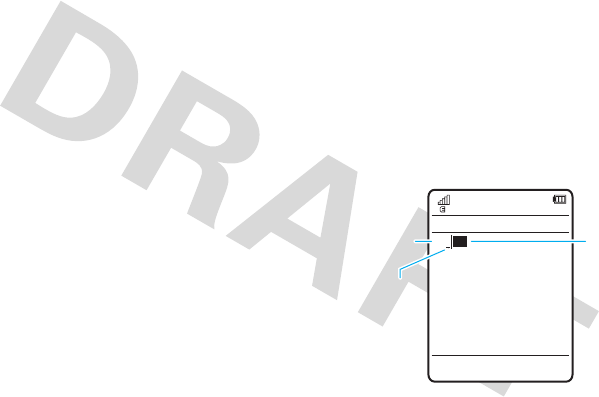
43
text entry
Set word learning:
Your phone can learn the words
you enter, to improve text prediction and completion. In
a text entry screen, press
Options
>
Text Entry
>
SetTextPrediction
>
Learn My Words
. Your phone shows
Ç
when word learning is active.
Set text completion:
Set your phone to complete
words based on the characters you enter. In a text
entry screen, press
Options
>
Text Entry
>
Set Text Prediction
>
Offer Completions
. Your phone shows
Æ
when text
completion is active.
Edit or delete text:
In a text entry screen, press
S
to
move the cursor to the right of text you want to edit.
Press the clear/back key
|
to delete the character left
of the cursor. Hold
|
to delete word by word.
word mode
To switch to “word” predictive text entry mode, press
#
in a text entry screen until you see
Ê
in the
display.
Word mode lets you enter words using one keypress
per letter. The phone predicts each word as you enter it.
For example, if you press
7764
, your
display might show:
Prog ram
Create Message
Options Send To
SMS:4
ÊÆ
You can
turn text
completion
on (
Æ
) or
off (
Ç
).
Press
|
to
delete
character to
left of cursor.
Press
*
to
enter
Prog
& a
space.
Press
S
up/down to
see other
words. Press
S
right to
select a word.
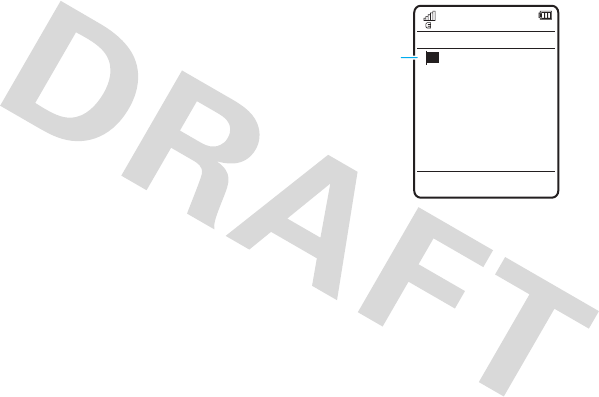
44
text entry
Tip:
Need to enter a symbol or punctuation? Press
#
until you see
Ã
to switch to symbol mode (for more
information, see page 45.
abc mode
To switch to “abc” text entry mode, press
#
in a text
entry screen until you see
É
in the display.
To enter text, press a keypad key repeatedly to cycle
through the letters and number on the key. Repeat this
step to enter each letter.
For example, if you press
7
one time, your display
might show:
When text completion is activated, your phone tries to
guess the rest of the word:
•
Press
s
to select the suggested word.
•
Press
S
right to enter the suggested word
and a space.
•
If you want a different word, press keypad keys
to enter the remaining letters.
P rog
Create Message
Options Send To
SMS:1
ÉÆ
After two
seconds,
character is
accepted
and cursor
moves to next
position.
Character
displays at
insertion point.

45
text entry
Shortcut:
To enter punctuation in abc mode, you can
press
1
to cycle through an assortment of commonly
used punctuation symbols.
numeric mode
Press
#
in a text entry screen until you see
È
. Press
the number keys to enter the numbers you want.
Tip:
Just need one number? To enter a number quickly,
press and hold a number key until the number appears.
symbol mode
Press
#
in a text entry screen until you see
Ã
.The
display shows the symbol associated with each keypad
key. Press
S
up/down repeatedly to see different
symbols. To insert a symbol, press its key, or scroll to it
and press
s
.

46
entertainment
entertainment
browser
Use your phone’s full HTML browser to surf to your
favorite Web sites, upload videos to a video blog, and
download files and applications to your phone. Log on
to your Internet-based email account to check your
email on the go.
Find it:
Press
T
Press
S
up/down/left/right to scroll through Web
pages. Scroll to a link and press
s
to select it.
Press
Back
at any time to return to the previous screen.
Some Web pages may contain a text entry window for
exchanging information with a Web site. Scroll to the
window, select it, and enter text as usual (for
information about entering text, see page 42).
To
go to a Web page
, press
Options
>
Go to
, enter the
Web address, and press
Go
.
To
bookmark
the current Web page, press
Options
>
Active Page
>
Add Bookmark
.
To go to a
bookmarked Web page
, press
Options
>
My Bookmarks
> bookmark.
To
change the homepage
that appears when you
open the browser, go to the Web page you want to
use, then press
Options
>
Active Page
>
Use asHomepage
.
To
upload
a video to a video blog site, see your
Quick Start Guide.
To
download
a media file, theme, or Java™ game or
application to your phone, go to the page that links to
the file, scroll to the link, and select it.
To
exit
the browser, press
Exit
.

47
entertainment
perform a Google search
Use your phone’s browser to perform a Web
search by using the Google Web site.
Find it:
Press
T
1
Press
Options
>
My Bookmarks
.
2
Press
S
to scroll to the
Google
bookmark, and
press
s
to select it.
3
Press
s
to select the Google text entry window.
4
Enter a search topic in the text entry window.
5
Press
S
down to scroll to the Google Search
button, and press
s
to select it.
The browser shows the results of your search.
check your email
Check your personal Web-based
email
account
(like Hotmail, Gmail, or Yahoo).
Find it:
Press
T
1
Press
Options
>
Go to
.
2
Enter the Web address for your Web-based email
account, then press
Go
.
manage certificates
Enable or disable Internet access certificates
stored on your phone.
Find it:
s
>
uSettings
>
Security
>
Certificates
Certificates are used to verify the identity and security
of Web sites when you download files or share
information.
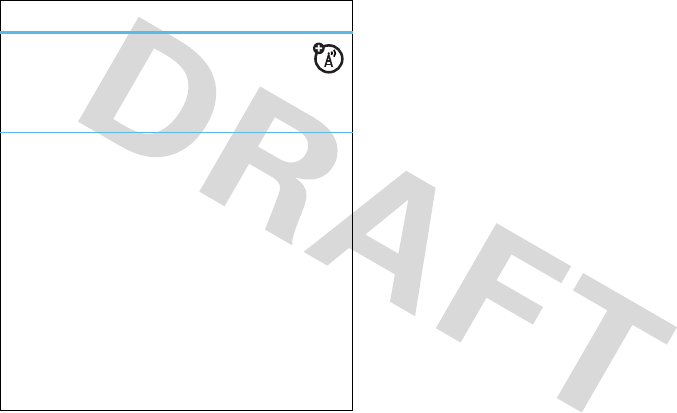
48
entertainment
fun & games
features
start a game or application
Start a Java™ game or application:
s
>
TGames
> game or application
airplane mode
Turn off your phone’s WiFi features, Bluetooth
wireless features, and calling features in locations
where wireless phone use is prohibited. This lets
you use the camera, music player, and other
non-network features while you are on an airplane,
without interfering with airplane communications.
s
>
uSettings
>
Phone Settings
>
Airplane Mode
>
On
To reactivate your phone’s calling features, turn off
airplane mode.

49
messages
messages
voicemail
Your network stores the voicemail messages
you receive. To listen to your messages, call
your voicemail number.
Note:
Your service provider may include additional
information about using this feature.
When you
receive
a voicemail message, your phone
shows
New Voicemail
, and the voicemail message indicator
(
appears at the top of the home screen.
To
check
voicemail messages:
Find it:
s
>
gMessaging
>
Voicemail
Shortcut:
Your service provider may store your
voicemail phone number in speed dial location 1. If so,
you can press and hold
1
in the home screen to
listen to your voicemail message(s).
text messages
send a message
A message can contain text and pictures,
sounds, or other media objects. You can add
multiple pages to a message and put text and media
objects on each page. You can send a message to other
compatible phones or to email addresses.
Find it:
s
>
gMessaging
>
Messages
>
Create Message
Shortcut:
From the home screen, press
Shortcuts
>
Create Message
.
1
Press keypad keys to enter text on the page (to
enter text, see page 42).
To insert a
picture, sound, or other media object
on the page, press
Options
>
Insert
. Select the file type

50
messages
and the file. (
Note:
File size restrictions may apply
to pictures and videos sent in a message.)
To insert
another page
, press
Options
>
Insert
>
Page
.
You can enter more text and objects on the new
page.
2
When you finish the message, press
Options
>
Sending Options
to set message options (such as
Subject
and
Priority
).
3
When you finish setting message options, press
Done
.
4
Press
Send To
to select message recipients. You can:
•
Select one or more entries from your contact
list (press
S
to scroll to an entry, and press
s
to select it).
•
Enter a new number or email address (press
Options
>
Enter Number
or
Enter Email
).
5
Press
Send
to send the message.
Your phone might tell you that this is a multimedia
message if it contains multiple pages or media
objects. Some phones or networks don’t support
multimedia messages. Press
Yes
to send the
message.
To save or cancel the message, press
Options
>
Save to Drafts
or
Cancel Message
.
Messages that you send are stored in the
Outbox
. Icons
next to each message show if the message was
sent
ñ
, if the send attempt was
successful
™
, or if
the send attempt
failed
~
. Press
Options
to perform
various operations on a message.
receive a message
When you receive a text message, your phone
plays an alert and shows
New Message
. The text
message indicator
]
appears at the top of the home
screen.

51
messages
To
read
the message, press
View
. If the message
contains media objects:
•
Pictures and animations show as you read the
message.
•
Sound files play as you read the message.
Press the volume keys on the side of your
phone to change the sound volume.
•
Attached files are added to the end of the
message. To open an attachment, select the
file indicator or file name.
To
answer
the message, press
Options
>
Reply
.
instant messaging
Use instant messaging to share messages with
your friends in real time.
Find it:
s
>
aIM
, scroll to your IM account, press
Log In
If you don’t have an IM account, select
[New Account]
to
create one.
To
find others
online, select
Contact List
to see a list of
other users.
To
start a conversation
, scroll to a name in the
Online Contacts
list and press
Send IM
.
To
open an active conversation
, scroll to a name in
the
Conversations
list and press
View
.
To end a conversation, press
Options
>
End Conversation
.
To
log out
from your instant messaging session, press
Options
>
Log Out
.
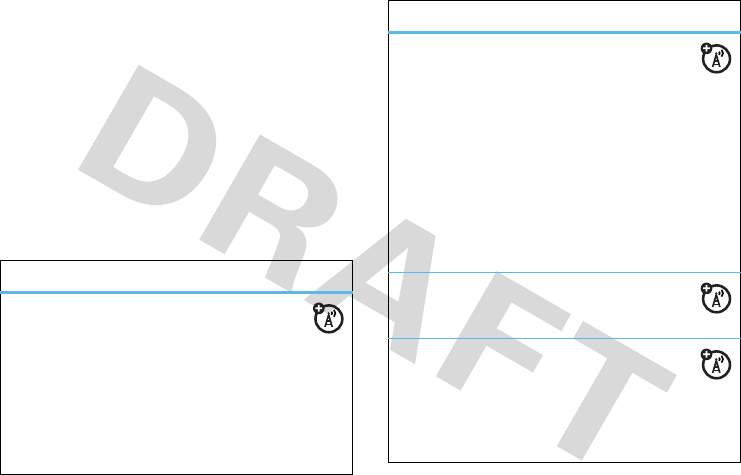
52
messages
create or edit an IM account
To create a new IM account:
Find it:
s
>
aIM
>
[New Account]
To edit an existing IM account:
Find it:
s
>
aIM
, scroll to an account, press
Options
>
Edit Account
more message features
features
send a prewritten quick note
s
>
gMessaging
>
Messages
>
Templates
>
Text Templates
> quick note, press
Options
>
Send
To create a new quick note:
s
>
gMessaging
>
Messages
>
Templates
>
Text Templates
,
press
Options
>
Create Template
set up an email account
You can set up and use multiple email
accounts on your phone:
s
>
gMessaging
>
Email
If no account exists, the phone prompts you to set
up a new email account.
Your phone shows a separate folder for each email
account.
send email
s
>
gMessaging
>
Email
use a multimedia template
Open a multimedia template with
pre-installed media:
s
>
gMessaging
>
Messages
>
Templates
>
MMS Templates
features
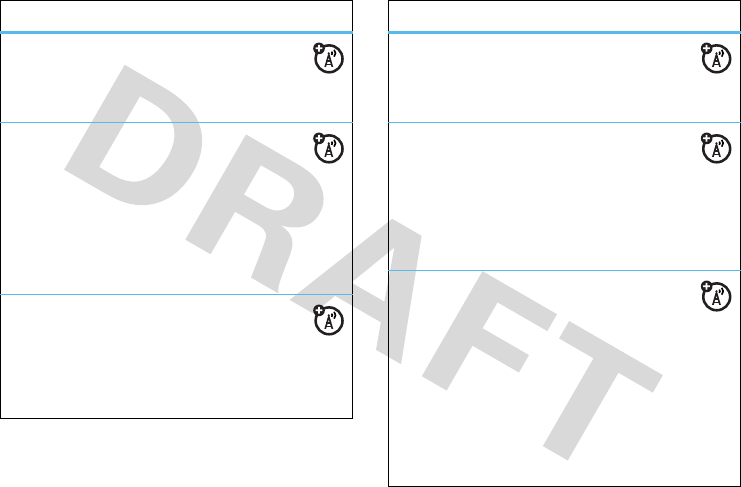
53
messages
read new message or email
When your display shows
New Message
, press
View
.
read old messages
s
>
gMessaging
>
Messages
>
Conversations
Icons next to each message show if it is
read
>
,
unread
]
,
urgent
<
, or has an
attachment
*
.
Press
Options
to perform various operations on a
message.
read old email
s
>
gMessaging
>
Email
> email folder
Press
Options
to perform various operations on a
message.
features
store message objects
Go to a multimedia message page, then
press
Options
>
Store
.
create folder
Create a personal folder to store your
messages.
s
>
gMessaging
>
Messages
>
My Folders
, press
Options
>
Create Folder
browser messages
Read messages received by your browser:
When your display shows
New Message
, press
View
.
To activate browser messages and adjust browser
message settings:
s
>
gMessaging
, press
Options
>
Message Settings
>
Browser Messages
features
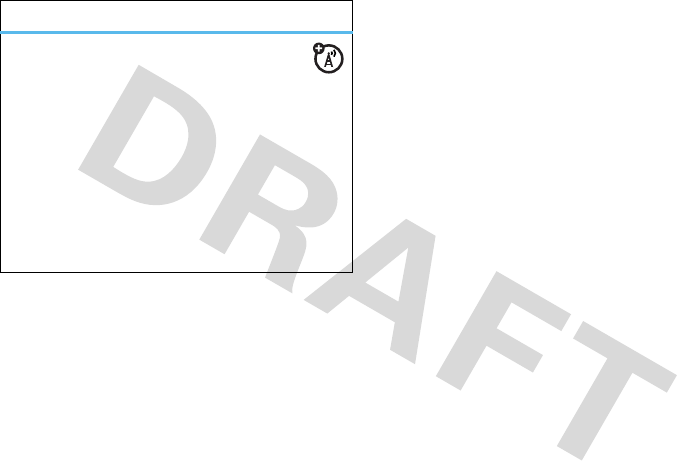
54
messages
info services
Read subscription-based information services
messages:
When your display shows
New Message
, press
View
.
To activate information services and adjust info
services settings:
s
>
gMessaging
, press
Options
>
Message Settings
>
Info Services
features
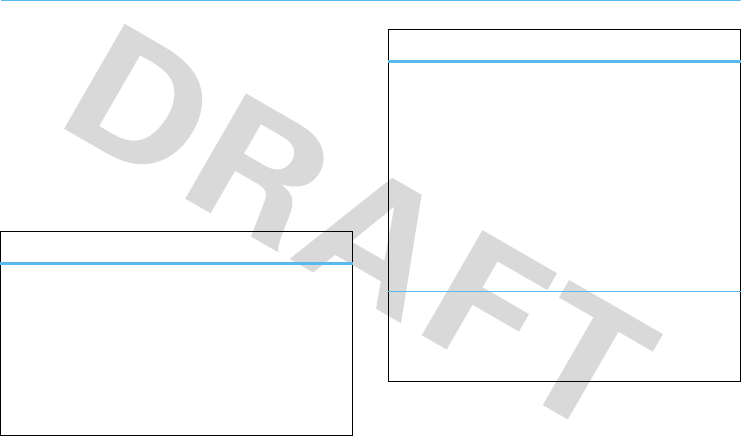
55
tools
tools
contacts
New contacts that you create are stored in both
phone
memory
and on your
SIM card
. The contact
information stored in phone memory can include
multiple phone numbers, email addresses, and
personal information. Only the contact name and
phone number(s) are stored on the SIM card
features
call a contact
s
>
LPhonebook
, scroll to the contact, press
¯
to
call
Note:
If a contact has multiple phone numbers or
email addresses, press
S
left/right to select the
number or email address you want.
store new contact
s
>
LPhonebook
, press
Options
>
Create
>
Contact
Shortcut:
From the home screen, press
Shortcuts
>
Create Contact
.
Press
S
left/right to select the
details
tab
â
,
address
tab
u
,
ID
tab
z
, or
notes
tab
x
. Press
S
up/down to scroll to information you want to
change, then press
s
to select it.
send message to contact
s
>
LPhonebook
, scroll to the contact, press
Options
>
Send
>
Message
features

56
tools
send email to contact
s
>
LPhonebook
, scroll to the contact, press
Options
>
Send
>
Email
Note:
This option appears only when the contact has
an email address.
add another phone number or email address to
contact
s
>
LPhonebook
, scroll to the contact, press
Options
>
Edit Contact
, press
S
left/right to select the
details
tab
â
, press
S
up/down to scroll to an empty
Number
or
Email
field, press
s
to select it
features
set picture ID for contact
Assign a photo or picture (picture ID) to show in the
display when you receive a call from a contact:
s
>
LPhonebook
, scroll to the contact, press
Options
>
Edit Contact
, press
S
left/right to select the
ID
tab
z
, press
S
up/down to scroll to
Picture ID
, press
s
to select it
set ring ID for contact
Assign a distinctive call alert (ring ID) for a contact:
s
>
LPhonebook
, scroll to the contact, press
Options
>
Edit Contact
, press
S
left/right to select the
ID
tab
z
, press
S
up/down to scroll to
Ringtone
, press
s
to select it
features
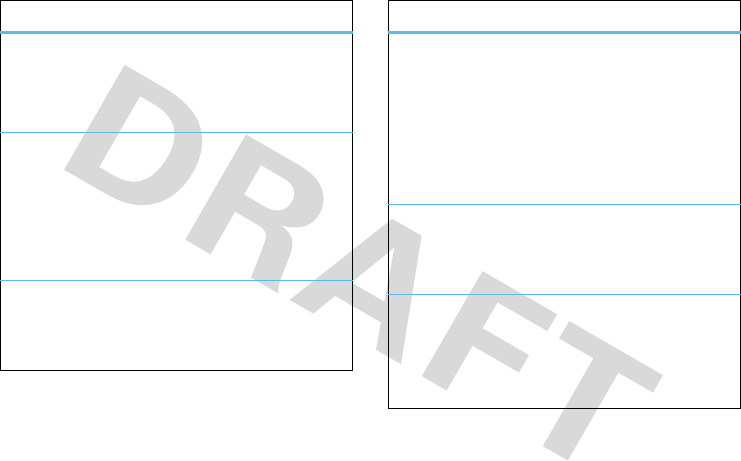
57
tools
create group
Add contacts to a group message list or email list:
s
>
LPhonebook
, press
Options
>
Create
>
Group
create and use private contacts
Identify one or more contacts as private contacts.
You must enter your six-digit security code to see the
private contacts on your contact list.
s
>
LPhonebook
, press
Options
>
Setup
>
Private Contacts
set contact list sort order
s
>
LPhonebook
, press
Options
>
Settings
>
Default Sort Order
>
First Name
or
Last Name
features
manage SIM card contacts
s
>
LPhonebook
, press
Options
>
Settings
>
SIM Card Manager
Delete contacts stored on your SIM card, or import
contact to the SIM card from phone memory, or
from another location.
copy SIM card contacts to phone memory
Press
s
>
LPhonebook
, press
Options
>
Import Contacts
>
SIM Card
, press
Options
>
Select All
, press
Import
.
copy phone memory contacts to SIM card
Press
s
>
LPhonebook
, press
Options
>
Setings
>
SIM Card Manager
, press
Options
>
Import Contacts
>
Phone Contacts
, press
Options
>
Select All
, press
Import
.
features
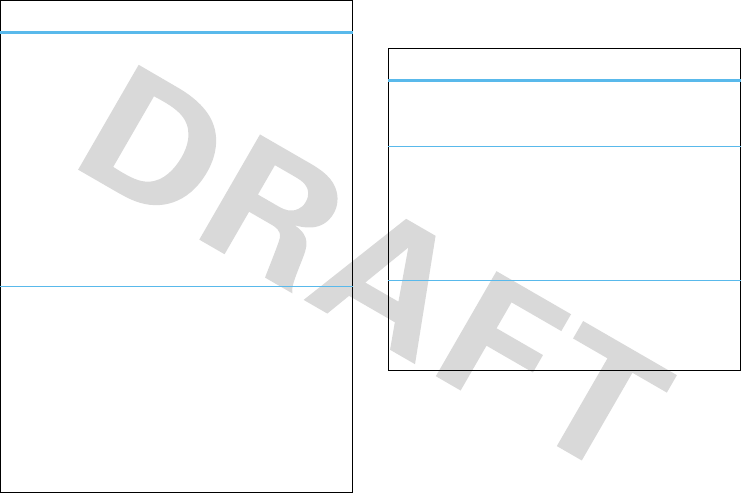
58
tools
personal organizer
send contact(s) to another device
Send one or more contacts to another phone,
computer, or device:
s
>
LPhonebook
, scroll to the contact, press
Options
>
Share
, press
s
to select the current contact, press
S
up/down to scroll to
Bluetooth
,
Messaging
, or
Email
transfer method, press
Select
to select it
To send multiple contacts, press
Options
>
Share
>
Multiple Contacts
(instead of the current contact).
delete contact(s)
Delete one or more contacts from your contact list:
s
>
LPhonebook
, scroll to the contact, press
Options
>
Delete
, press
s
to select the current contact,
press
Yes
to confirm deletion
To delete multiple contacts, press
Options
>
Delete
>
Multiple Contacts
(instead of the current contact).
features
features
set alarm
s
>
mTools
>
Alarm Clock
turn off alarm
When the display shows an alarm:
To turn off the alarm, press
Dismiss
or
–
.
To set an eight-minute delay, press
Snooze
.
set calendar default view
s
>
mTools
>
Calendar
, press
Options
>
Calendar Setup
>
Default View
>
Month
or
Week
or
Day
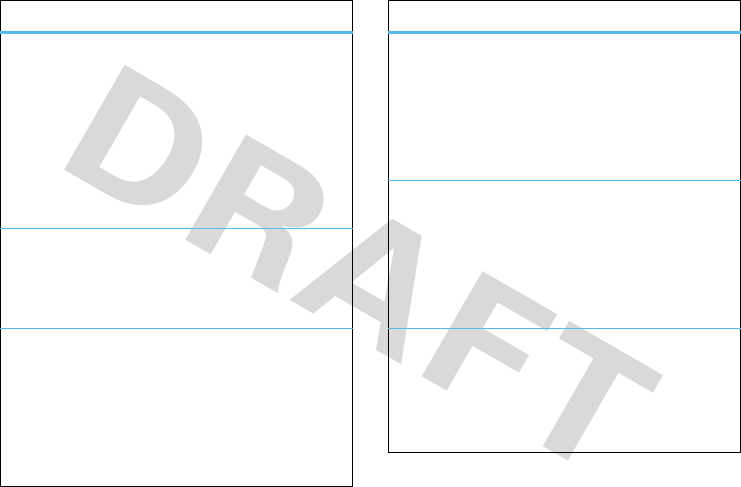
59
tools
add new calendar event
s
>
mTools
>
Calendar
, scroll to the day and/or start
time, press
s
, enter event details
You can set a music or sound file, voice note, or
video as an event reminder alert. When creating a
calendar event, select
CalendarAlert
> alarm type, scroll
to the file (or create a new file), press
Insert
.
see calendar event
s
>
mTools
>
Calendar
> event
To edit event details, press
Options
>
Edit
.
calendar event reminder
When the display shows an event reminder (and
optionally plays an event reminder alert):
To see reminder details, select
Open Event
.
To close the reminder, press
Dismiss
.
features
send calendar event to another device
Send a calendar event to another phone, computer,
or device:
s
>
mTools
>
Calendar
> event, press
Options
>
Share via
>
Bluetooth
or
Message
or
Email
manage downloaded files
Manage files and applications that you’ve
downloaded onto your phone from the browser or
over a Bluetooth® connection:
s
>
mTools
>
DownloadManager
world clock
Show time and date information for multiple cities
around the world:
s
>
mTools
>
World Clock
features
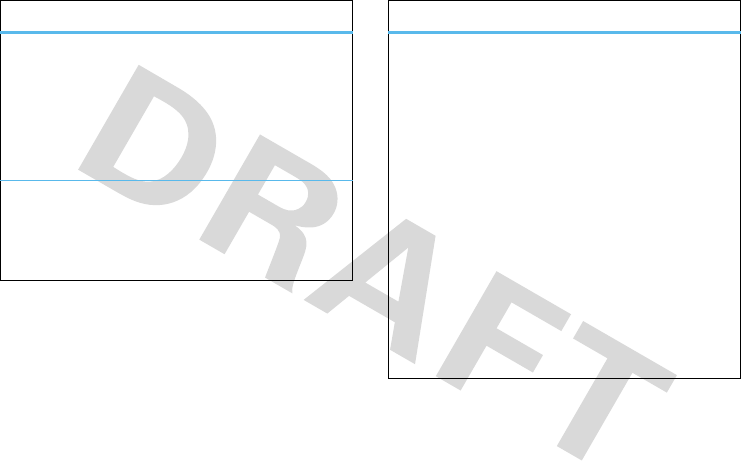
60
tools
task list
Create a checklist of tasks you need to perform, and
set your phone to notify you when task deadlines
arrive:
s
>
mTools
>
Task List
notes
Write and store notes on your phone:
s
>
mTools
>
Notes
features
record voice note
Record a voice note reminder to yourself, or record a
phone call in progress:
s
>
jMultimedia
>
Voice Recorder
, press
s
to start
recording, press
Stop
to stop recording
To save the voice note, press
Save
.
To perform various operations on the voice note,
press
Options
.
Note:
Recording of phone calls is subject to varying
State and Federal laws regarding privacy and
recording of phone conversations. Always obey the
laws and regulations on the use of this feature.
features
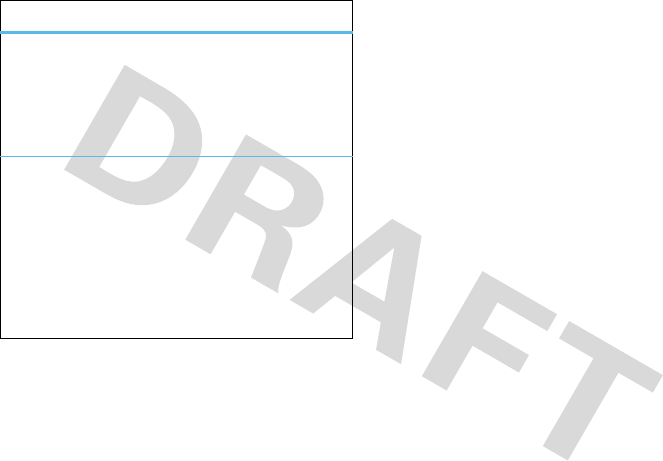
61
tools
play voice note
Play back a voice note you’ve recorded:
s
>
jMultimedia
>
MediaFinder
>
Voice Notes
>voice note
calculator
s
>
mTools
>
Calculator
To use the calculator as a currency converter:
s
>
mTools
>
Calculator
, press
Options
>
Set Exchange Rate
,
enter exchange rate, press
Set
, enter amount, press
Options
>
Convert Currency
features

62
connections
connections
Bluetooth® wireless
Your phone supports Bluetooth wireless
connections. You can connect your phone with
an optional Bluetooth headset or Bluetooth car kit to
make handsfree calls, or with a set of Bluetooth stereo
headphones to listen to music stored on your phone.
Connect your phone with a device that supports
Bluetooth connections to exchange files, connect with
a printer that supports Bluetooth connections to print
images, or use your phone as a Bluetooth wireless
modem to connect to the Internet.
For maximum Bluetooth security
, you should always
connect Bluetooth devices in a safe, private
environment.
turn Bluetooth power on & off
Your phone automatically turns Bluetooth power on
when you use a Bluetooth feature.
To turn Bluetooth power on or off at any time:
Find it:
s
>
uSettings
>
Bluetooth
, press
Options
>
Setup Bluetooth
>
Bluetooth Power
>
On
or
Off
Note:
To extend battery life and maximize Bluetooth
security, use this procedure to set Bluetooth power to
Off
when not in use. Your phone will not connect to
another device until you use a Bluetooth feature again,
or set Bluetooth power back to
On
.

63
connections
use a Bluetooth headset or
handsfree car kit
Before you try to connect your phone to a
handsfree device for the first time
, make sure the
device is
on
and
ready
in pairing or bonding mode (see
the device user’s guide). You can connect your phone
with only one device at a time.
Find it:
s
>
uSettings
>
Bluetooth
, press
Options
>
Search For Device
>
Headset
Shortcut:
From the home screen, press
Shortcuts
>
Find Bluetooth Devices
.
Your phone lists the Bluetooth audio devices it finds
within range.
1
Scroll to a device in the list.
2
Press
s
to connect with the highlighted device.
copy files to a device
You can copy a media file, contact, calendar event, or
bookmark to another phone or computer that supports
Bluetooth connections.
Note:
You can’t copy some copyrighted objects.
Before you try to copy a file to another device
, make
sure the receiving device is
on
and
ready
in
discoverable mode. Also, make sure the device is not
busy with another Bluetooth connection.
1
On your phone, scroll to the object that you want
to copy to the other device.
2
Press
Options
, then select:
•
Send via
>
Bluetooth
for an image or sound file,
calendar event, or bookmakr.
•
Share
> contact >
Bluetooth
for a contact.

64
connections
3
Select a recognized device name.
or
Select
[Search For Devices]
to search for new devices,
then select the device where you want to copy the
object.
4
Press
Options
>
Send
.
5
If necessary, enter a mutually agreed upon
passkey (such as
0000
) on your phone and the
device, then press
OK
to connect to the device.
Your phone shows
Sending
while the file is transferred.
When file transfer is complete, the phone shows
Send Successful
, and prompts you to press
OK
to continue.
receive files from a device
Before you try to receive a file from another device
,
make sure your phone’s Bluetooth power is
on
(see
page 62).
Place your phone within range (approximately
10 meters/30 feet) of the other Bluetooth device, and
send the file from the device.
If your phone and the sending device were not
previously paired, place your phone in discoverable
mode so the sending device can locate it. Press
s
>
uSettings
>
Bluetooth
, press
Options
>
Discoverable On 3 Minutes
. The Bluetooth indicator
&
in the
home screen flashes when your phone is in
discoverable mode.
Your phone shows
Incoming Transfer
while the file is
transferred. When file transfer is complete, the phone
shows
Successful
, and tells you where the file was stored.
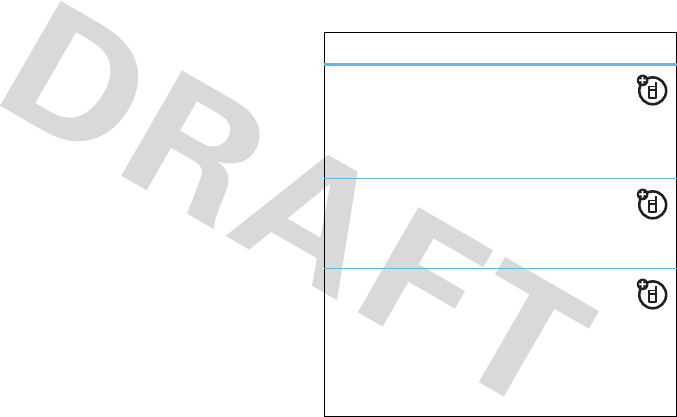
65
connections
send a photo to a printer
You can send a photo to a printer that supports
Bluetooth connections.
Note:
You can print A4, US Letter, and 4x6 size pages.
To print another size, copy the image to a linked
computer and print it from there.
1
On your phone, take a new photo or scroll to a
stored image that you want to print, then press
Options
>
Print via
>
Bluetooth
.
Note:
If you see
Service Not Supported
when you try to
print, select
Send To
>
Bluetooth
instead. (The
Send To
option does not print the image name or date
stamp.)
2
Select a recognized printer name, or press
Options
>
Search For Printers
to search for another printer where
you want to send the image.
3
If available, modify print options.
more Bluetooth features
Note:
A device is recognized after you connect to it
once (see page 63).
features
pair with recognized device
Press
s
>
uSettings
>
Bluetooth
, press
S
left to select the
My Devices
tab, press
S
up/down to
scroll to the device name, press
s
to connect.
drop connection with device
Scroll to the connected device name and
press
s
to disconnect.
remove device from device list
Scroll to the device name and press
Options
>
Remove Device
.
Note:
You can’t remove a device from the list while
your phone is connected to the device.
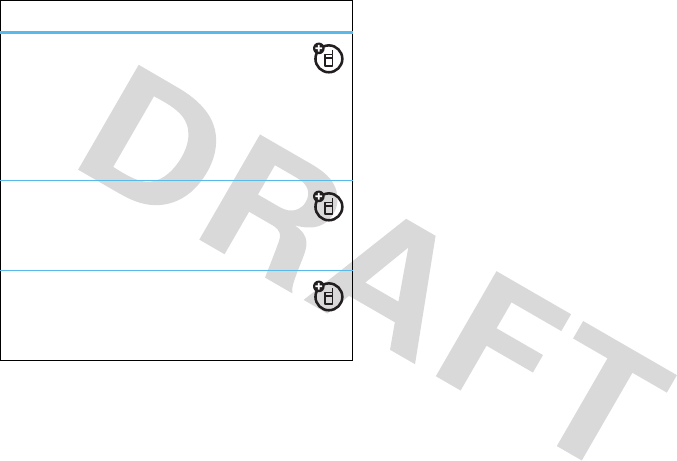
66
connections
WiFi Internet connection
You can use your phone to make and receive calls over
a WiFi CERTIFIED® wireless connection, if your
service provider supports Internet calls using
Voice-over-Internet Protocol (VoIP) or
Session Initiation Protocol (SIP).
To use an Internet connection (instead of a cellular
network connection), you must connect to your service
provider through a wireless connection over a
wlan access point.
Note: Your phone's WiFi features are not allowed
for outdoor operation in France. To avoid unlawful
interference with radio signals, do not use the WiFi
features in France unless you are indoors.
switch audio to Bluetooth® headset or
Bluetooth car kit during call
Press
Options
>
Use Bluetooth
.
To switch audio back to the phone, press
Options
>
Use Handset
.
edit properties of recognized device
Scroll to the device name, press
Options
>
Edit Device
.
set Bluetooth® options
Press
s
>
uSettings
>
Bluetooth
, press
Options
>
Setup Bluetooth
.
features

67
connections
available networks list
To see a list of available access points within range of
your phone:
Find it:
s
>
uSettings
>
WiFi
>
Available Networks
Your phone lists available access points. The orange
WiFi signal strength indicator
À
shows the strength of
each WiFi connection. Other indicators can include:
Scroll to the network access point you want to use,
then press
s
to select it.
create a WiFi network connection
To create and save a WiFi connection with a
network access point:
Find it:
s
>
uSettings
>
WiFi
>
Available Networks
1
Scroll to the WiFi network of your choice and press
s
.
2
If prompted by your phone, enter the secret key,
then press
Continue
.
3
When the connection is established, make sure
you save the profile. To save the profile, scroll to
the WiFi network with the active network
connection indicator
Ã
, and press
Options
>
Save
.
Your phone creates a secure connection with the
network, and saves the network profile in the
Saved Networks
list.
Note:
Your phone automatically connects to a network
in the
Saved Networks
list when the phone is within range
of the network access point.
Á
= saved network
Ä
= secure access
point
Ã
= active network
connection
Â
= active saved
network connection
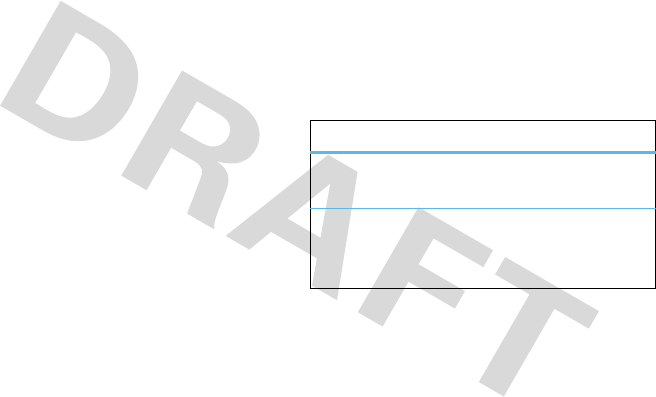
68
connections
quick connect
To have your phone automatically locate and connect to
a WiFi network access point:
Find it:
s
>
uSettings
>
WiFi
>
Quick Connect
Your phone connects to the network access point with
the best signal strength within range of your phone. If
the first connection fails, the phone connects to the
next available network.
saved networks list
To see the network connection profiles you’ve saved on
your phone:
Find it:
s
>
uSettings
>
WiFi
>
Saved Networks
Note:
Your phone automatically connects to a network
in the
Saved Networks
list when the phone is within range
of the network access point.
manually add network to list
To manually set up a network access point and add it to
the list:
Find it:
s
>
uSettings
>
WiFi
>
Set Up WiFi
>
Add New Network
>
Enter Network Info
You must enter the following configuration settings:
options
SSID
Enter the broadcast name that
identifies the wireless access point.
Profile Name
Enter the name you want to use to
identify the access point in the
Saved Networks
list.
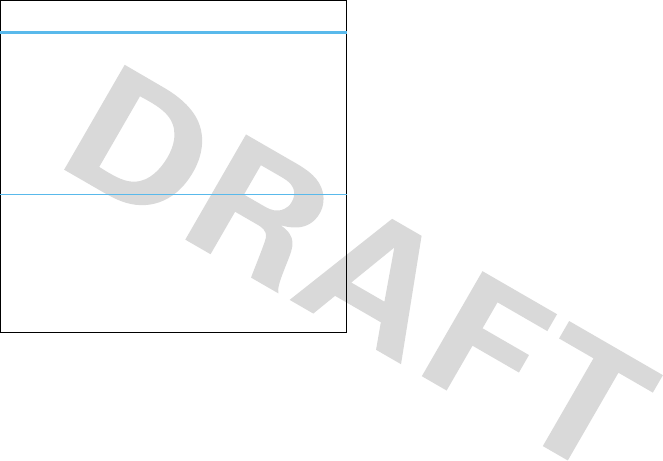
69
connections
view or edit a network profile
Find it:
s
>
uSettings
>
WiFi
>
Saved Networks
, scroll to
the network, press
Options
>
Edit
send network profile
To send a network profile in an SMS text message to
another phone or compatible device:
Find it:
s
>
uSettings
>
WiFi
>
Saved Networks
, scroll to
the network, press
Options
>
Send To
receive network profile
Your phone notifies you when you receive a network
profile message from another phone or PC.
Press
Options
, then press
Save
to save the network profile
to your
Saved Networks
list.
Tip:
Press
Options
, then press
View
to see network details
before you save the network profile to your phone.
Security Type
Select the security type for the access
point.
Depending on the security type, you
may be prompted to enter the
Passphrase
or
Network Key
for the access
point.
Non- Broadcast
SSID
Select this option if the name of your
access point is not being broadcast.
Tip:
Check the available networks list
to see if the access point name is
being broadcast.
options
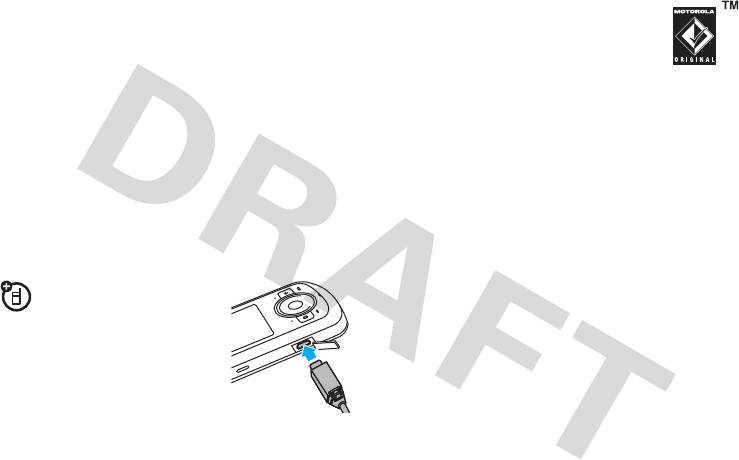
70
connections
turn WiFi power on or off
Find it:
s
>
uSettings
>
WiFi
>
WiFi Power
>
On
or
Off
Note:
•
To extend battery life, use this procedure to
turn off WiFi power when not in use.
•
Turning off WiFi power may prevent your voice
service over WiFi from working.
cable connections
To transfer data between
your phone and a
computer, insert the micro USB
port connector plug from a USB
cable into your phone’s micro USB
port. Connect the other end of the
cable to the computer.
Note:
A Motorola Original USB cable and
supporting software may be included with
your phone. These tools are also sold
separately. Check your computer to
determine the type of cable you need.
Note:
Some phone functions are temporarily
unavailable when a USB connection is active.
To use Windows® Media Player 11 to sync music files
from a computer to your phone: Press
s
>
uSettings
>
Connections
>
USB Settings
>
MediaSynch/PlayFromDevice
, then
connect your phone to the computer. For more
information, see your Quick Start Guide.
To manually transfer music, pictures, and videos
between your computer and phone (phone memory or
installed memory card): Press
s
>
uSettings
>
Connections
>
USB Settings
>
Memory Card
, then connect your
phone to the computer. For more information, see your
Quick Start Guide.

71
connections
To use your phone as a modem: Press
s
>
uSettings
>
Connections
>
USB Settings
>
Modem
), then connect your
phone to the computer.
To
transfer contact lists and calendar entries
between your phone and computer: Connect your
phone to the computer, then open the optional
Motorola Phone Tools accessory application on the
computer. You can also use the Motorola Phone Tools
application to transfer and sync music files from the
computer to your phone. The Phone Tools software
automatically switches your phone to the proper
connection setting required to sync the phone. See the
Phone Tools user’s guide for more information.
To make data calls through a computer: Press
s
>
uSettings
>
Connections
>
USB Settings
>
Modem
, then
connect your phone to the computer. Use the
computer application to place or answer the call.
To create a new data connection on your phone, press
s
>
uSettings
>
Connections
>
DataConnections
>
Add aConnection
).
To print an image over a USB PictBridge connection:
Press
s
>
uSettings
>
Connections
>
USB Settings
>
USB Printing
, then connect your phone to a
PictBridge-compatible printer. Select the image(s) you
want to print, then press
Options
>
Print via
>
USB
.
end a USB connection
Caution:
Do not disconnect your phone from the
computer while files are being transferred.
On a PC running Windows XP™ or later:
When file
transfer is complete, remove the USB cable from your
phone and computer.
On a PC running an earlier version of Windows OS:
Click the Safely Remove Hardware icon in the system
tray at the bottom of your computer screen, then select

72
connections
Safely Remove USB Mass Storage Device. Remove the
USB cable from your phone and computer.
On a Macintosh® computer:
Select and drag the
Removable Disk icon to the Trash. Remove the USB
cable from your phone and computer
sync
You can use several different over-the-air
connection methods to synchronize information
between your phone and a remote server.
Exchange ActiveSync
Use the Internet to synchronize your phone’s
contact list, calendar entries, and email with an
email account on a Microsoft® Exchange 2003 server.
set up Exchange ActiveSync
Confirm that the
Mobility
option is enabled on the
email account, and that
data service
is activated with
your phone service provider (additional fees may apply
for this service).
To set up an ActiveSync partner:
Find it:
s
>
mTools
>
Sync
>
Exchange ActiveSync
Enter your email account and server information,
including
User Name
,
Password
,
Domain Name
,
Server Name
, and
DataConnection
details. If necessary, contact your system
administrator to obtain the information you need, or to
help you connect your phone to the server.
use Exchange ActiveSync
Schedule your phone to
automatically
synchronize
data with an Exchange ActiveSync partner:
Find it:
s
>
mTools
>
Sync
>
Exchange ActiveSync
, press
Options
>
Edit
>
Auto Sync
>
On
, press
OK
to enter the time
and days you want to synchronize

73
connections
To
manually
synchronize your contacts, calendar, and
email:
Find it:
s
>
mTools
>
Sync
>
Exchange ActiveSync
press
Options
>
Sync
The first synchronization may take several minutes,
depending on the amount of data in your contacts list,
calendar, and email on the Exchange 2003 server.
SyncML
Call a SyncML Internet server and synchronize
your phone’s contact list and calendar entries
with the server.
To
synchronize files
with a partner you set up:
Find it:
s
>
mTools
>
Sync
>
SyncML
If no SyncML profile is stored on your phone, the
phone prompts you to create a profile. Contact your IT
system administrator to obtain the information you
need to set up a profile.
Note:
If your phone can’t connect to the server, verify
that your phone’s network service provider has data
service activated on your phone (additional fees may
apply for this service).
file manager
Manage music and sound files, photos, videos, and
other files stored on your phone, and on an optional
removable microSD memory card.
Find it:
s
>
mTools
>
File Manager
Select a folder or
Memory Card
to see its contents.
To
play
a sound file or voice note, or
view
a photo or
video, just scroll to the file and select it.
To
edit
a file: Scroll to the file and press
Options
>
Manage
to copy, move, or rename it. Other options let you
delete, send, or apply the file. You can’t perform some
operations on some copyrighted or pre-installed files.

74
connections
To
copy files
between your phone and a computer, you
can use a cable connection (see following section) or a
Bluetooth® connection (see page 63).
format memory card
You must format a new memory card before you can
use it with your phone.
Caution:
Formatting a memory card
erases
all files
stored on the memory card.
To format an installed memory card:
Find it:
s
>
mTools
>
File Manager
1
Press
S
to scroll to the memory card.
2
Press
Options
>
Manage
>
Format
.
3
Select
Format
to confirm that you want to format the
memory card.
see memory card properties
To see memory card properties (such as name and
available memory):
Find it:
s
>
mTools
>
File Manager
1
Press
S
to scroll to the memory card.
2
Press
Options
>
Manage
>
Properties
.
move or copy files between phone
and memory card
Caution:
When you
move
a file to a new location, the
file is
deleted
from its original location.
Find it:
s
>
mTools
>
File Manager
1
Scroll to the file you want to move or copy.
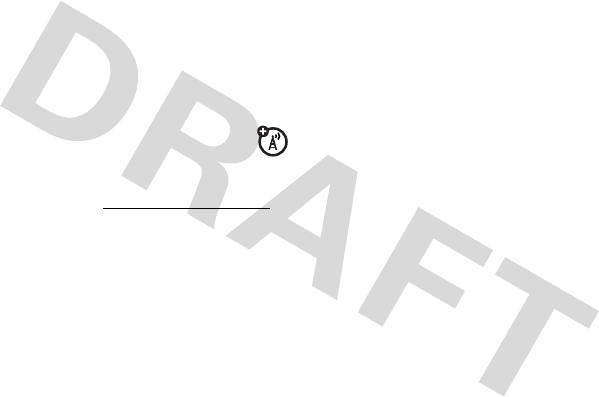
75
connections
2
Press
Options
>
Manage
>
Move
or
Copy
.
Note:
The
Move
and
Copy
options do not appear if the
file is copyright-protected.
3
Scroll to the destination location, then press
Place
.
phone software updates
Sometimes, we think of ways to make your
phone’s software faster or more efficient after
you’ve purchased your phone. You can find out if your
phone can be updated at:
www.hellomoto.com/update
Your service provider may send updated phone
software over-the-air to your phone. When your phone
receives a software update, you can install it
immediately, or defer installation until later. To install a
deferred software update:
Find it:
s
>
uSettings
>
Phone Settings
>
Update Software

76
service & repairs
service & repairs
If you have questions or need assistance, we're here to
help.
Go to
www.motorola.com/support
, where you can select
from a number of customer care options. You can also
contact the Motorola Customer Support Center at
1-800-331-6456 (United States), 1-888-390-6456
(TTY/TDD United States for hearing impaired), or
1-800-461-4575 (Canada).

77
service & repairs
Specific Absorption Rate Data
SAR Data
This model wireless phone meets the
government’s requirements for exposure to radio
waves.
Your wireless phone is a radio transmitter and receiver. It is
designed and manufactured not to exceed limits for exposure to
radio frequency (RF) energy set by the Federal Communications
Commission (FCC) of the U.S. Government and by the Canadian
regulatory authorities. These limits are part of comprehensive
guidelines and establish permitted levels of RF energy for the
general population. The guidelines are based on standards that
were developed by independent scientific organizations through
periodic and thorough evaluation of scientific studies. The
standards include a substantial safety margin designed to assure
the safety of all persons, regardless of age or health.
The exposure standard for wireless mobile phones employs a unit
of measurement known as the Specific Absorption Rate, or SAR.
The SAR limit set by the FCC and by the Canadian regulatory
authorities is 1.6 W/kg.
1
Tests for SAR are conducted using
standard operating positions accepted by the FCC and by Industry
Canada with the phone transmitting at its highest certified power
level in all tested frequency bands. Although the SAR is
determined at the highest certified power level, the actual SAR
level of the phone while operating can be well below the
maximum value. This is because the phone is designed to operate
at multiple power levels so as to use only the power required to
reach the network. In general, the closer you are to a wireless
base station, the lower the power output.
Before a phone model is available for sale to the public in the U.S.
and Canada, it must be tested and certified to the FCC and Industry
Canada that it does not exceed the limit established by each
government for safe exposure. The tests are performed in
positions and locations (e.g., at the ear and worn on the body)
reported to the FCC and available for review by Industry Canada.
The highest SAR value for this model phone when tested for use at
the ear is 0.66 W/kg, and when worn on the body, as described in
this user guide, is 0.92 W/kg. (Body-worn measurements differ
among phone models, depending upon available accessories and
regulatory requirements).
2
While there may be differences between the SAR levels of various
phones and at various positions, they all meet the governmental
requirements for safe exposure. Please note that improvements to
this product model could cause differences in the SAR value for
later products; in all cases, products are designed to be within the
guidelines.

78
WHO Information
Information from the World Health Organization
WHO Information
Present scientific information does not indicate the need for any special
precautions for the use of mobile phones. If you are concerned, you may
want to limit your own or your children’s RF exposure by limiting the
length of calls or by using handsfree devices to keep mobile phones
away from your head and body.
Source: WHO Fact Sheet 193
Further information:
http://www.who.int./peh-emf
Privacy and Data Security
Priva cy and Data Security
Motorola understands that privacy and data security are important to
everyone. Because some features of your mobile device may affect your
privacy or data security, please follow these recommendations to
enhance protection of your information:
• Monitor access
—Keep your mobile device with you and do
not leave it where others may have unmonitored access. Lock
your device’s keypad where this feature is available.
• Keep software up to date
—If Motorola or a
software/application vendor releases a patch or software fix
for your mobile device that updates the device’s security,
install it as soon as possible.
• Erase before recycling
—Delete personal information or
data from your mobile device prior to disposing of it or turning
it in for recycling. For step-by-step instructions on how to
delete all personal information from your device, see the
section entitled “master clear” or “delete data” in the user’s
guide.
Note:
For information on backing up your mobile device data
before erasing it, go to
www.motorola.com
and navigate to
the “downloads” section of the consumer Web page for
“Motorola Backup” or “Motorola Phone Tools.”
• Understanding AGPS
—To provide location information for
emergency calls, certain Motorola mobile devices incorporate
Assisted Global Positioning System (AGPS) technology. AGPS
technology also can be used in non-emergency applications to
track and monitor a user’s location—for example, to provide
driving directions. Users who prefer not to permit such
tracking and monitoring should avoid using such applications.
If you have further questions regarding how the use of your mobile
device may impact your privacy or data security, please contact
Motorola at
privacy@motorola.com
, or contact your service provider.
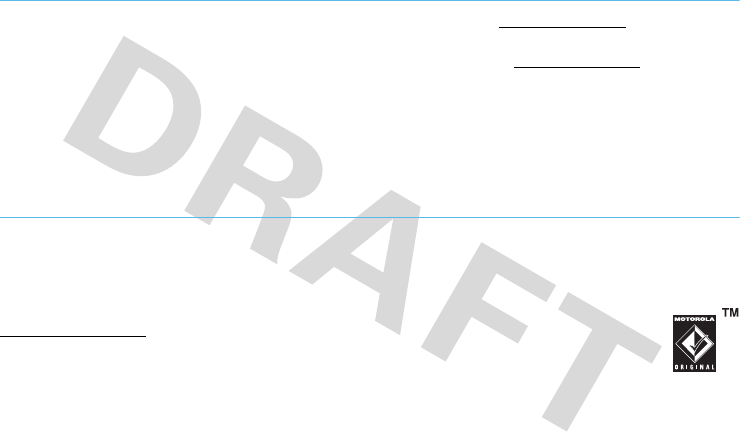
79
OSS Information
OPEN SOURCE SOFTWARE INFORMATION
OSS Informat ion
For instructions on how to obtain a copy of any source code being made
publicly available by Motorola related to software used in this Motorola
mobile device you may send your request in writing to:
The Motorola website
opensource.motorola.com
also contains
information regarding Motorola’s use of open source.
Motorola has created the
opensource.motorola.com
to serve as a portal
for interaction with the software community-at-large.
To view additional information regarding licenses, acknowledgments
and required copyright notices for open source packages used in this
Motorola mobile device, please select “Legal Notices” from Phone
Settings.
Smart Practices While Driving
Drivi ng Safety
Drive Safe, Call Smart
Check the laws and regulations on the use of mobile devices
and their accessories in the areas where you drive. Always obey
them. The use of these devices may be prohibited or restricted in
certain areas—for example, handsfree use only. Go to
www.motorola.com/callsmart
(in English only) for more
information.
Your mobile device lets you communicate by voice and data—almost
anywhere, anytime, wherever wireless service is available and safe
conditions allow. When driving a car, driving is your first responsibility.
If you choose to use your mobile device while driving, remember the
following tips:
• Get to know your Motorola mobile device and its
features such as speed dial and redial.
If available, these
features help you to place your call without taking your
attention off the road.
• When available, use a handsfree device.
If possible, add an additional layer of
convenience to your mobile device with one
of the many Motorola Original handsfree
accessories available today.
• Position your mobile device within easy reach.
Be able
to access your mobile device without removing your eyes from
the road. If you receive an incoming call at an inconvenient
time, if possible, let your voicemail answer it for you.
MOTOROLA, INC.
OSS Management
600 North US Hwy 45
Libertyville, IL 60048
USA

80
Driving Safety
• Let the person you are speaking with know you are
driving; if necessary, suspend the call in heavy traffic
or hazardous weather conditions.
Rain, sleet, snow, ice,
and even heavy traffic can be hazardous.
• Do not take notes or look up phone numbers while
driving.
Jotting down a “to do” list or going through your
address book takes attention away from your primary
responsibility—driving safely.
• Dial sensibly and assess the traffic; if possible, place
calls when your car is not moving or before pulling into
traffic.
If you must make a call while moving, dial only a few
numbers, check the road and your mirrors, then continue.
• Do not engage in stressful or emotional conversations
that may be distracting.
Make people you are talking with
aware you are driving and suspend conversations that can
divert your attention away from the road.
• Use your mobile device to call for help.
Dial 911 or other
local emergency number in the case of fire, traffic accident, or
medical emergencies.*
• Use your mobile device to help others in emergencies.
If you see an auto accident, crime in progress, or other serious
emergency where lives are in danger, call 911 or other local
emergency number, as you would want others to do for you.*
• Call roadside assistance or a special non-emergency
wireless assistance number when necessary.
If you see
a broken-down vehicle posing no serious hazard, a broken
traffic signal, a minor traffic accident where no one appears
injured, or a vehicle you know to be stolen, call roadside
assistance or other special non-emergency wireless number.*
* Wherever wireless phone service is available.

81
index
index
A
access point connection 66
accessories 36, 62
active line indicator 20
active line, change 40
airplane mode 23, 48
alarm clock 58
alert
set 26, 28
turn off 21, 33
alert style indicator 20
answer options 36
B
battery indicator 20
battery life, extend 31, 62, 70
Bluetooth indicator 19
Bluetooth wireless 62
bonding. See Bluetooth wireless
brightness 30
browser 46, 47, 53, 59
browser messages 53
C
calculator 61
calendar
add event 59
send event 59
set view 58
synchronize 72, 73
call
answer options 36
waiting 39
call alert 56
call barring 24, 40
call forward indicator 20
call forwarding 40
call timers 37, 38
caller ID 35, 56
camera 1
car kit 36
center key 14
certificates 47
clear/back key 43
clock 27
codes 24, 25
conference call 39

82
index
contact list
add entry 55
copy contacts to phone or SIM
57
picture ID 35
send contact 58
synchronize 72, 73
costs, track 37
customer support 76
customize 26
D
data call 37, 38
date 27
delete data 32
delete text 43
dial a phone number 41
dialed calls 33
display 2, 18, 30
download files 46
download manager 59
drafts folder 50
driving tips 79
DTMF tones 41
E
earpiece volume 21
EDGE indicator 19
email
read 53
send 52
synchronize 72
email address 55
emergency number 35
Enter Unlock Code message 24
F
file manager 73
fixed dial 41
forward calls 40
G
GPRS indicator 19
group mailing list 57
H
handsfree speaker 1, 24
headset 36
headset jack 1
hold a call 39
home screen 2, 18
I
IM 51
IM indicators 19, 20
in-call indicator 20
Incoming Call message 35
information services 54
instant messaging. See IM
international access code 39
Internet connection 66

83
index
K
keypad 36
keypad volume, adjust 26
L
language 31
lanyard hook 1
line 1 and line 2 20
linking. See Bluetooth wireless
location indicator 20
lock
applications 25
phone 25
SIM card 25
lock key 1
Low Battery message 20
M
media playback 26
media volume, adjust 26
memory card 74
menu 2, 18
menu icons 18
message
read 50, 53
send 49
message indicator 20, 50
messaging. See IM
micro USB port 1
micro-USB port 15
Missed Calls message 34
multimedia message 49
mute a call 39
N
navigation key 14
network settings 41
notes 60
number entry 45
P
pair with recognized device 65
pairing. See Bluetooth wireless
passwords. See codes
personalize 26
phone number
store 55
your number 40
picture ID 35, 56
PIN code 24, 25
PIN2 code 24, 41
predictive text entry 43
printing 65, 71
Q
quick note 52
R
radio 21
received calls 33

84
index
recent calls 33
redial 34
repairs 76
reset settings 31
return a call 34
ring ID 35, 56
ringer volume, adjust 26, 27
ringtone 26, 28
S
saved networks 67
screensaver 28, 31
security code 24
service dial 41
side select key 1, 21
signal strength indicator 19
silent alert style 26
SIM Blocked message 25
SIM card 24, 25, 41
SIM card, delete information 32
SIP 66
skin 28
soft keys 18
software update 75
speakerphone 36
speed dial 38
store phone numbers 55
support 76
symbol entry 45
synchronize 72, 73
T
talking phone 23
task list 60
technical support 76
templates 52
text edit 43
text entry 42
text message 49
text templates 52
theme 28
time 27
timers 37, 38
transfer a call 40
TTY device 40
U
unlock
applications 25
phone 24, 25
SIM card 25
unlock code 24, 25
V
vibrate alert style 26
voice commands 21
voice dial 21, 36
voice note 60, 61
voice quality 33
voicemail 49

86
index
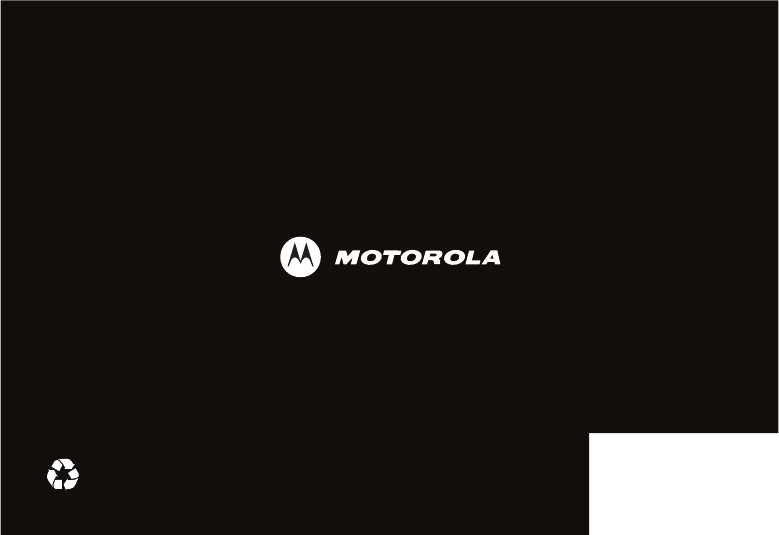
www.motorola.com
